日本刑事技術協会所属 元静岡県警警部
講演講師 渡邉晃人

渡邉晃人と申します。
私は現在、「犯罪」を専門とする講演講師として、地域の皆様と協力し、青少年の非行防止と更生を目的とした育成活動に携わっております。対象は地域の子供たちや若者です。また、保護司として警察や地域社会と連携し、更生を必要とする方々がスムーズに社会復帰できるよう支援を推進しています。
My name is Akihito Watanabe.
My target audience is local children and young people. In addition, as a volunteer probation officer, I work with the police and the local community to promote support for people in need of rehabilitation so that they can smoothly reintegrate into society.
青少年の有害環境対策の推進
近年、若者を取り巻く社会環境と意識の変化は、デジタル化の進展に伴い、孤独や孤立化が顕著になっています。その結果、「いじめ」「自殺」「家出」「違法薬物の入手・乱用」「児童買春・児童ポルノ」「特殊詐欺」や「匿名流動型犯罪」など、ソーシャルメディアを利用した青少年犯罪が増加傾向にあります。
私は、少年犯罪の防止に貢献するため、小・中・高・専門学校・大学など、各教育委員会や地方自治体などで、青少年の育成と犯罪撲滅に向けた講演活動を幅広く行っています。
未来ある若者たちに「夢を持って堂々と生きてほしい」「楽しい人生を歩んでほしい」「彼らに勇気を与えたい」という強い思いから、「常に彼らの声に耳を傾け」「彼らの目線で共に学び」相互の理解を深めながら、心に響く講演を心がけています。
また、地域社会に向けた防犯講座では、防犯落語を取り入れた「鶴の恩返し」「長屋の特殊詐欺」「おまわりさんと酔っ払い」「寄席踊り」などの小噺を交え、元刑事としての経験に基づいたリアリティ溢れる講演を、幅広い世代の方々に向けてテレビやラジオ、インターネットなどを活用して発信しています。
Promoting countermeasures against harmful environments surrounding youth
In recent years, the social environment and changing awareness surrounding young people have led to a marked increase in loneliness and isolation, driven by the advancement of digitalization. As a result, there has been a growing trend in juvenile crime involving social media, including “bullying,” “suicide,” “running away from home,” “acquisition and abuse of illegal drugs,” “child prostitution and child pornography,” “specialized fraud,” and “anonymous fluid crime.”
To contribute to the prevention of juvenile crime, I conduct a wide range of lecture activities at various educational institutions, such as elementary, junior high, senior high, vocational schools, and universities, as well as at local boards of education and municipalities, aimed at fostering youth development and eradicating crime.
With a strong desire for young people with a future to “live proudly with dreams,” “lead fulfilling lives,” and “be given courage,” I strive to deliver impactful lectures that resonate with their hearts, “always listening to their voices,” “learning together from their perspective,” and deepening mutual understanding.
Furthermore, in crime prevention lectures for the local community, I incorporate storytelling with a crime prevention theme, including humorous stories such as “The Crane’s Gratitude,” “Specialized Fraud in the Tenement,” “The Policeman and the Drunkard,” and “Yose Dance,” combining them with realistic lectures based on my experience as a former detective. These are disseminated to a wide range of generations through television, radio, and the internet.
人間力を育む教育とは
これからご紹介する人物には共通点があります。
それは、生きとし生けるものへの「生命への畏敬」、惜しみない人間愛、人を育む力、そして「教育の本質」への深い理解です。
一般的に教育とは何かと尋ねると、知識を教え知能を高めること、心身を育成すること、才能を伸ばすことなど、さまざまな答えが返ってきます。しかし、私は教育の目的は、自身の生の意味を知り、人生の目的や意義を探求しながら、与えられた才能や才覚で自身の役割を果たし、生涯幸福に生きるための基礎を築くことだと考えます。
そして、個々の特性と精神に合った、将来に役立つ実践的な教育こそが、実力主義が求められる現代において必要とされているのではないでしょうか。
その上で、虐めや自殺問題に深く関係する教育的視点から「ウィリアム・スミス・クラーク」「マザー・テレサ」「アルベルト・シュヴァイツァー」をご紹介します。
諸君、適材適所、オンリーワンを目指せ!
Education to Foster Human Skills
The individuals I am about to introduce share several common traits: a “reverence for life” towards all living beings, boundless love for humanity, the ability to nurture others, and a deep understanding of the “essence of education.”
When asked what education is, people typically respond with various answers such as teaching knowledge and enhancing intelligence, cultivating the mind and body, or developing talents. However, I believe that the purpose of education is to understand the meaning of one’s own life, to explore one’s purpose and significance in life, to fulfill one’s role with one’s given talents and abilities, and to build a foundation for a lifetime of happiness.
Furthermore, in today’s meritocratic society, what is needed is practical education that is tailored to individual characteristics and spirits, and that will be useful in the future.
In light of this, I would like to introduce William Smith Clark, Mother Teresa, and Albert Schweitzer, from an educational perspective that is deeply related to the issues of bullying and suicide.
Gentlemen, aim for the right person in the right place, aim to be the only one!
ウィリアム・スミス・クラーク
[1826〜1886]米国の教育家。マサチューセッツ農科大学長。
1876年(明治9)来日。札幌農学校(国立北海道大学の前進)の初代教頭となり、キリスト教精神に基づく新教育を提唱し在日1年足らずだったが、内村鑑三・新渡戸稲造(にとべいなぞう)らの学生に深い感化を及ぼした。
ウィリアム・スミス・クラーク 全人教育の理念
William Smith Clark
[1826-1886] An American educator. President of Massachusetts Agricultural College.
He came to Japan in 1876 (Meiji 9). He became the first vice principal of Sapporo Agricultural College (the predecessor of Hokkaido University) and advocated a new education based on the spirit of Christianity. Although his stay in Japan was less than a year, he had a profound influence on students such as Kanzo Uchimura and Inazo Nitobe.
William Smith Clark: The Philosophy of Holistic Education
表題タイトルに戻る
青年よ大志をもて
青年よ大志をもて
それは金銭や我欲のためにではなく、また人呼んで名声という空しいもののためであってはならない。
人間として当然そなえていなければならぬあらゆることを成しとげるために大志をもて。
Boys, be ambitious!
Be ambitious not for money or for selfish aggrandizement, not for that evanescent thing which men call fame.
Be ambitious for the attainment of all that a man ought to be.
クラークは、校則で学生を縛るのではなく、自らが立案した規律を守らせることこそが真の紳士を育成する道であると説き、『be a gentleman』という言葉でそれを表現しました。
クラークが提唱した全人的教育思想は、教える者と学ぶ者が信頼という絆で結ばれた時に始まります。教師と生徒が一人の人間として向き合い、知識や技術の習得に偏ることなく、感性や徳性などを重視することで、人間性を総合的に育むことを目指しました。基礎学力と倫理観を調和的に発展させることを教育方針として打ち出したのです。
Boys, be ambitious!
Boys, be ambitious!
Be ambitious not for money or for selfish aggrandizement, not for that evanescent thing which men call fame.
Be ambitious for the attainment of all that a man ought to be.
Clark advocated that the path to fostering true gentlemen lies not in binding students with school rules, but in having them adhere to self-imposed discipline, expressing this with the phrase “be a gentleman.”
Clark’s holistic educational philosophy begins when those who teach and those who learn are connected by bonds of trust. By teachers and students facing each other as individuals, without being biased towards the acquisition of knowledge and skills, and by emphasizing sensibilities and virtues, he aimed to comprehensively nurture human character. He set forth an educational policy of harmoniously developing basic academic abilities and ethical values.
虐めと全人教育について
虐めと全人教育は、一見すると無関係のように思えるかもしれませんが、実は深く関係しています。全人教育とは、知識や技能だけでなく、人格、道徳、社会性など、人間としてのあらゆる側面を育成することを目的とした教育理念です。
全人教育が虐め防止に繋がる理由
豊かな人間性の育成: 全人教育は、相手を尊重し、共感する心を育むことを重視します。これにより、他者の痛みを理解し、虐めを未然に防ぐことができます。
道徳教育を通じて、正しい倫理観や価値観を養い、虐めを「許されない行為」として認識させることができます。
コミュニケーション能力の向上:
全人教育は、自己表現や他者との対話などのコミュニケーション能力を高めることを重視します。これにより、虐めの背景にある誤解や不満を解消し、より良い人間関係を築くことができます。
自己肯定感の育成
全人教育は、一人ひとりの個性や才能を伸ばし、自己肯定感を高めることを重視します。自己肯定感の高い子どもは、他者への攻撃性が低く、虐めの加害者や被害者になりにくい傾向があります。
社会性の育成: 全人教育は、社会の一員としての責任感や協調性を育むことを重視します。これにより、虐めを「社会全体の課題」として捉え、周囲と協力して解決に取り組むことができます。
全人教育の具体的な取り組み
道徳教育の充実:道徳の授業だけでなく、日々の教育活動全体を通して、道徳的な判断力や実践力を養います。
体験活動の重視: ボランティア活動や自然体験活動など、様々な体験を通して、他者との関わりや社会との繋がりを学びます。
カウンセリング体制の強化:いじめの早期発見・早期対応のために、専門家によるカウンセリング体制を整えます。
地域との連携 学校、家庭、地域が連携し、子どもたちを支える体制を構築します。
文部科学省の見解
文部科学省も、虐め防止対策推進法において、全人教育の重要性を強調しています。
「児童等の豊かな情操と道徳心を培い、心の通う対人交流の能力の素地を養うことが虐めの防止に資することを踏まえ、全ての教育活動を通じた道徳教育及び体験活動等の充実を図らなければならない。」
このように、全人教育は、いじめ問題を根本的に解決するための重要な鍵となります。
Bullying and Holistic Education
Bullying and holistic education may seem unrelated at first glance, but they are actually deeply connected. Holistic education is an educational philosophy that aims to develop all aspects of a person, not just knowledge and skills, but also character, morality, and social skills.
How Holistic Education Leads to Bullying Prevention
Cultivating a Rich Humanity: Holistic education emphasizes fostering respect for others and empathy. This makes it possible to understand the pain of others and prevent bullying before it occurs.
・Through moral education, it is possible to cultivate a correct sense of ethics and values, and to recognize bullying as an “unforgivable act.”
Improving Communication Skills: Holistic education emphasizes enhancing communication skills such as self-expression and dialogue with others. This can resolve misunderstandings and dissatisfaction behind bullying, and build better relationships.
Fostering Self-Esteem: Holistic education emphasizes developing the individuality and talents of each person and enhancing self-esteem. Children with high self-esteem tend to be less aggressive towards others and are less likely to become bullies or victims of bullying.
Developing Social Skills: Holistic education emphasizes fostering a sense of responsibility and cooperation as a member of society. This makes it possible to recognize bullying as a “problem for society as a whole” and work together with those around us to solve it.
Specific Initiatives of Holistic Education
Enhancing Moral Education: Cultivate moral judgment and practical skills not only in moral classes but also throughout daily educational activities.
Emphasis on Experiential Activities: Learn about interactions with others and connections with society through various experiences such as volunteer activities and nature experiences.
Strengthening the Counseling System: Establish a counseling system by experts for early detection and early response to bullying.
Collaboration with the Community: Schools, families, and communities work together to build a system to support children.
Views of the Ministry of Education, Culture, Sports, Science and Technology (MEXT)
MEXT also emphasizes the importance of holistic education in the Act on Promotion of Measures to Prevent Bullying.
“Based on the fact that cultivating children’s rich emotions and morality, and fostering the foundation for interpersonal communication skills with heartfelt communication, contributes to the prevention of bullying, moral education and experiential activities through all educational activities must be enhanced.”
In this way, holistic education is an important key to fundamentally solving the problem of bullying.
Reference Materials
Basic Recognition and Key Points of Efforts Regarding Bullying Problems in Schools – Ministry of Education, Culture, Sports, Science and Technology
Act on Promotion of Measures to Prevent Bullying – Ministry of Education, Culture, Sports, Science and Technology
アルベルト・シュヴァイツァー
成功が幸せへの鍵ではない。幸せが成功への鍵だ。あなたがやっていることを愛していれば、あなたは成功するだろう。
Albert Schweitzer
Success is not the key to happiness. Happiness is the key to success. If you love what you are doing, you will be successful.

表題タイトルに戻る
アルベルト・シュヴァイツァー 生命への畏敬 虐めの考察
アルベルト・シュヴァイツァー博士の言葉は、いじめ問題について考える上で、いくつかの重要な示唆を与えてくれます。博士の言葉を紐解きながら、いじめ問題との関連性を考察してみましょう。
1. 「生命への畏敬」の思想
シュヴァイツァー博士は、「生命への畏敬」を倫理の根本に据えました。これは、人間だけでなく、あらゆる生命に対して深い敬意を払い、その尊厳を守るべきであるという考え方です。
いじめは、被害者の尊厳を著しく傷つけ、心身に深い傷跡を残します。生命への畏敬の思想は、いじめを「生命に対する冒涜」と捉え、断じて許されない行為であることを教えてくれます。
2. 「他者への責任」の思想
シュヴァイツァー博士は、私たちは他者の幸福に対して責任を負っていると考えました。これは、他者の苦しみや悲しみに寄り添い、共に生きる社会を築くべきであるという考え方です。
いじめは、被害者を孤立させ、深い苦しみを与えます。他者への責任の思想は、いじめを傍観せず、積極的に介入し、被害者を支援することの重要性を教えてくれます。
3. 「倫理的自己変革」の思想
シュヴァイツァー博士は、倫理的な社会を実現するためには、私たち一人ひとりが自己変革する必要があると訴えました。これは、自らの内面を見つめ、倫理的な意識を高める努力を怠らないことの重要性を教えてくれます。
いじめは、加害者の倫理観の欠如によって引き起こされることが多いです。倫理的自己変革の思想は、いじめの加害者に対して、自らの行為を深く反省し、倫理的な人間へと成長することを促します。
シュヴァイツァー博士の言葉から学ぶ、いじめ問題への向き合い方
生命の尊厳を深く認識し、いじめを許さない社会を築く。
他者の苦しみに寄り添い、いじめの被害者を積極的に支援する。
私たち一人ひとりが倫理的な意識を高め、いじめの加害者を生まない社会を目指す。シュヴァイツァー博士の言葉は、いじめ問題の解決に向けて、私たちに多くの示唆を与えてくれます。博士の思想を参考に、いじめのない社会を実現するために、私たち一人ひとりができることを考えていきましょう。
Reverence for Life - Reflections on Bullying
The words of Dr. Albert Schweitzer offer several important insights when considering the issue of bullying. Let us explore the connection to the problem of bullying by unraveling his words.
1・The Philosophy of “Reverence for Life”
Dr. Schweitzer placed “reverence for life” at the foundation of ethics. This is the idea that we should pay deep respect not only to human beings but to all life, and protect its dignity.
Bullying severely damages the dignity of the victim, leaving deep physical and mental scars. The philosophy of reverence for life teaches us that bullying is an “affront to life” and an act that can never be tolerated.
2・The Philosophy of “Responsibility for Others”
Dr. Schweitzer believed that we are responsible for the happiness of others. This is the idea that we should empathize with the suffering and sorrow of others and build a society in which we live together.
Bullying isolates the victim and causes deep suffering. The philosophy of responsibility for others teaches us the importance of not standing by and watching bullying, but actively intervening and supporting the victim.
3・The Philosophy of “Ethical Self-Transformation”
Dr. Schweitzer argued that each of us needs to transform ourselves in order to realize an ethical society. This teaches us the importance of looking into our own hearts and making an effort to raise our ethical awareness.
Bullying is often caused by a lack of ethical awareness on the part of the perpetrator. The philosophy of ethical self-transformation encourages the perpetrators of bullying to deeply reflect on their own behavior and grow into ethical human beings.
How to Approach the Issue of Bullying by Learning from the Words of Dr. Schweitzer
・Deeply recognize the dignity of life and build a society that does not tolerate bullying.
・Empathize with the suffering of others and actively support the victims of bullying.
・Each of us should raise our ethical awareness and aim for a society that does not produce bullies.
The words of Dr. Schweitzer give us many insights toward solving the problem of bullying. With reference to his philosophy, let each of us consider what we can do to realize a society without bullying.
Just be yourselfish

表題タイトルに戻る
マザーテレサ 虐めの考察について
マザー・テレサの言葉は、いじめ問題について考える上で、いくつかの重要な示唆を与えてくれます。
マザー・テレサの言葉と、いじめ問題への示唆
「愛の反対は憎しみではなく、無関心です。」
いじめは、被害者への無関心、あるいは加害者の優越感や自己肯定感の欠如から生じることがあります。この言葉は、傍観者も含めた私たち一人ひとりが、いじめに対して無関心でいるのではなく、積極的に関わり、行動することの重要性を教えてくれます。
「もし、私たちに平和がないのは、私たちが忘れているからです。私たちはお互いに属しているということを。」 いじめは、他者への共感や思いやりの欠如から生じることがあります。この言葉は、私たち一人ひとりが、他者とのつながりを意識し、尊重し合うことの大切さを教えてくれます。
「小さいことの中に、大きな愛をこめてください。」
いじめられている人は、孤独感や絶望感を感じているかもしれません。 この言葉は、小さな思いやりや行動が、いじめられている人の心を救い、勇気づける力になることを教えてくれます。
いじめ問題への具体的な行動
マザー・テレサの言葉を踏まえ、私たちにできることは以下の通りです。
いじめを見かけたら、傍観者にならず、声をかける。
いじめられている人がいたら、話を聞き、寄り添う。
いじめられている人がいたら、先生や親など、信頼できる大人に相談するよう促す。 日頃から、相手を尊重し、思いやりのある言動を心がける。
子どもたちに、マザー・テレサの言葉を通して、愛と思いやり、そして他者への共感の大切さを伝える。
マザー・テレサへ活動や言葉を参考に、私たち一人ひとりが、いじめ問題について考え、行動していくことが大切です。
マザーテレサ 人生の提唱
人生とは機会です。そこから恩恵を受けてください。
人生とは夢です。それを実現してください。
人生とは挑戦です。それをかなえてください。
人生とは義務です。それを完成しとげください。
人生とはゲームです。それを楽しんでください。
人生とは約束です。それを果たしてください。
人生とは悲しみです。それを乗り越えてください。
人生とは歌です。それを歌ってください。
人生とは苦労です。それを受け入れてください。
人生とは悲劇です。それを慰めてください。
人生とは冒険です。それを思い切ってやってください。
人生とは運です。それを作っていってください。
人生とはあまりにも貴重なものです。
それを壊さないでください。人生とは生きることです。
戦いぬいてください。
Mother Teresa: Reflections on Bullying
Mother Teresa’s Words and Insights into Bullying
“The opposite of love is not hate, it’s indifference.”
・Bullying can arise from indifference towards the victim, or from the perpetrator’s sense of superiority or lack of self-esteem. This statement teaches us the importance of each one of us, including bystanders, actively engaging and taking action against bullying, rather than remaining indifferent.
“If we have no peace, it is because we have forgotten that we belong to each other.”
・Bullying can stem from a lack of empathy and compassion for others. This statement reminds us of the importance of being aware of our connection with others and respecting each other.
“Do small things with great love.”
・Those who are bullied may feel loneliness and despair. This statement teaches us that small acts of kindness and compassion can save and encourage the hearts of those who are bullied.
Specific Actions to Address Bullying
Based on Mother Teresa’s words, here are actions we can take:
・If you witness bullying, don’t be a bystander; speak up.
・If someone is being bullied, listen to them and support them.
・If someone is being bullied, encourage them to seek help from a trusted adult, such as a teacher or parent.
・Always strive to be respectful and compassionate in your words and actions.
・Through Mother Teresa’s words, convey the importance of love, compassion, and empathy towards others to children.
It is important for each of us to reflect on and act against bullying, taking inspiration from Mother Teresa’s work and words.
Mother Teresa: Advocacy for Life
Life is an opportunity, benefit from it.
Life is a dream, realize it.
Life is a challenge, meet it.
Life is a duty, complete it.
Life is a game, play it.
Life is a promise, fulfill it.
Life is sorrow, overcome it.
Life is a song, sing it.
Life is a struggle, accept it.
Life is a tragedy, console it.
Life is an adventure, dare it.
Life is luck, make it.
Life is too precious, do not destroy it.
Life is life, fight for it.
虐めについて About bullying
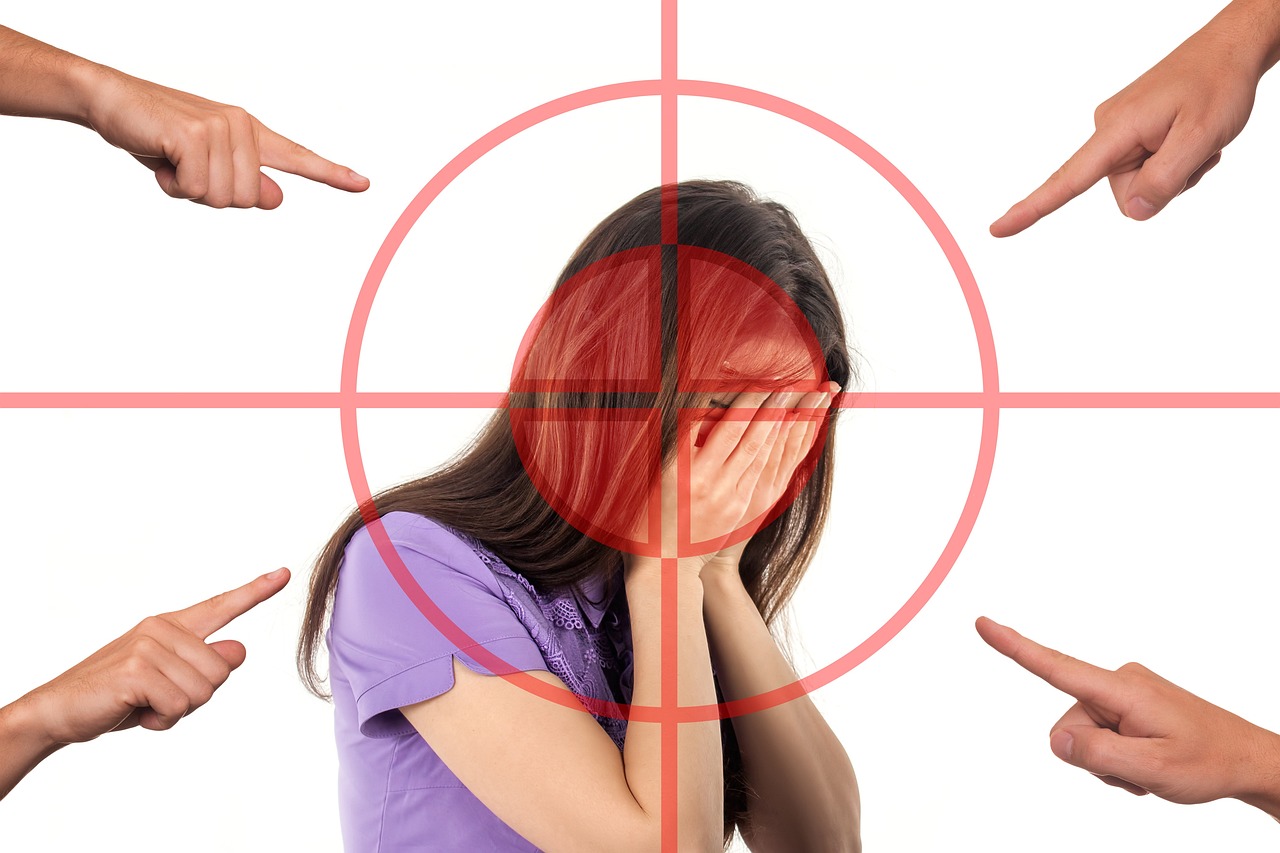
表題タイトルに戻る
虐めについて
虐めの原因
虐めは、複雑な要因が絡み合って発生する現象であり、単一の原因で説明することはできません。
主な要因としては、以下のものが考えられます。
1・個人的な要因
「ストレスや不満」
主に、家庭や学校でのストレス・友人関係の悩み・成績不振などが原因で、他者を攻撃することでストレスを発散しようとするなどのケースが見受けられます。
「自己肯定感の低と欠落」
自分に自信が持てず、他人を攻撃することで優位に立とうとするなどの心理的要因が場あります。
「共感性の欠如」
他者の気持ちを理解したり、想像したりすることが苦手な場合、虐めがエスカレートしやすい傾向がありますので行動面での注意が必要です。
「過去の経験」
過去に虐められた経験を持つ人が、今度は加害者になる場合があります。これには幾つも要因があります。
2・社会的な要因
「集団心理」
集団の中で、特定の個人を攻撃することで一体感が生まれ、虐めがエスカレートするケースが目立ちます。
「傍観者の存在」
周囲の人が見て見ぬふりをすることで、虐めが助長される場合が多々見られます。事なかれ主義、関わらないのが得策、見て見ぬ振りをする、火中の栗は拾わない、自分も虐めの対象になりたくないなどの恐怖心から傍観者となり自分を守ろうとします。虐めにおいて相手の痛みを学ぶ道徳や倫理的教育が求められます。
「情報化社会の影響」
インターネットやSNSの普及により、匿名での誹謗中傷や、虐めの拡散が容易になり、深刻化する場合があります。
「競争社会」
競争が激しい社会では、他者を蹴落とすことが正当化されやすく、虐めにつながる場合があります。
「多様性の欠如」
異質なものを排除しようとする心理が働き、虐めにつながる場合があります。
3・環境的な要因
「家庭環境」
親の過干渉や無関心、家庭内暴力などが、子どものストレスや攻撃性を高める場合があります。
「学校環境」
教師の目が届きにくい場所や時間帯、虐めを許容するような雰囲気などが、虐めを助長する場合があります。
「地域社会」
地域社会のつながりが希薄な場合、子どもたちの孤立感や不安感が高まり、虐めにつながる場合があります。
これらの要因は、互いに複雑に絡み合って、虐めの発生やエスカレートに影響を与えます。虐めを防止するためには、これらの要因を総合的に理解し、多角的な対策を講じる必がります。
4・虐め被害者の心理
主に、周囲から拒絶されていると感じ、逃げ場のない心理状態に陥いり無力感が増大し、自己肯定感が著しく低下する。
うつ病やPTSD(心的外傷後ストレス障害)を発症するリスクやパニック障害などの後遺症が生じる場合もある。また、虐めによる心理的影響は深刻であり、身体的影響も無視できない。
「虐めの長期的な影響」
虐め側の加害者は、自己抑制が困難になり社会に適応できなくなることがある。将来的に、素行障害(行為障害)、反社会性パーソナリティ障害などの精神疾患を発症したり、非行や犯罪に走るリスクが高まる。
5・虐めと遺伝的要因
虐めは、遺伝的要因と環境的要因が複雑に絡み合って発生する現象であり、遺伝的要因だけで説明することはできません。しかし、近年の研究では、いじめに関与する可能性のある遺伝子がいくつか特定されつつあります。
「気分の調節や攻撃性に関連する遺伝子」
セロトニン輸送体遺伝子;セロトニンは、気分の調節や感情の安定に関与する神経伝達物質です。この遺伝子の変異は、気分の落ち込みやすさや攻撃性の高さに関連すると考えられています。
ドーパミン受容体遺伝子;ドーパミンは、快感や意欲に関与する神経伝達物質です。この遺伝子の変異は、衝動性や攻撃性の高さに関連すると考えられています。
「共感性や社会性に関連する遺伝子」
オキシトシン受容体遺伝子;オキシトシンは、愛情や信頼感に関与するホルモンです。この遺伝子の変異は、共感性の低さや社会性の欠如に関連すると考えられています。
「ストレス反応に関連する遺伝子」
コルチゾール受容体遺伝子;コルチゾールは、ストレス反応に関与するホルモンです。この遺伝子の変異は、ストレスに対する過剰な反応や、ストレスによる精神的な脆弱性に関連すると考えられています。
「遺伝的要因と環境的要因の相互作用」
これらの遺伝子は、単独で虐めを引き起こすのではなく、環境的要因と相互作用することで、虐めのリスクを高める可能性があります。例えば、遺伝的に攻撃性の高い子どもが、家庭や学校で暴力的な環境にさらされると、虐めの加害者になるリスクが高まるかもしれません。
注意点
これらの研究はまだ初期段階であり、虐めに関与するすべての遺伝子が特定されているわけではありません。
遺伝的要因は、虐めのリスクを高める可能性の一つに過ぎず、環境的要因や個人の性格なども大きく影響します。
遺伝子検査によって虐めのリスクを予測することは、現時点では困難です。
虐めは、複雑な要因が絡み合って発生する現象であり、遺伝的要因だけでなく、環境的要因や個人の性格なども考慮する必要があります。いじめを防止するためには、遺伝的要因に関する研究を進めるとともに、家庭や学校、地域社会全体でいじめを許さない環境づくりに取り組むことが重要です。
6・虐待環境と虐めとの因果関係
虐待と虐めは、複雑に絡み合っている場合があります。
「虐待の連鎖とは」
虐待の連鎖とは、虐待を受けた人が、成長して親など養育者になった際に、自分の子どもなど養育する人に虐待をしてしまうことです。
「虐待と虐めの関連性」
虐待を受けた子どもが虐めの加害者になる場合。
虐待によって、子どもはストレスや怒りを抱えやすくなります。
そのストレスや怒りを、弱い立場の人に向けることで、虐めの加害者となることがあります。また、虐待によって、暴力的な言動を学習しそれが他者への攻撃性につながる可能性もあります。
「虐待を受けた子どもが虐めの被害者になる場合」
虐待によって、自己肯定感が低くなり、自分を守る力が弱まることがあります。また、周囲の人の顔色をうかがうなど、過度に受動的な態度をとることがあり、虐めの標的になりやすいことがあります。
7・虐待といじめの共通点
どちらも、力の不均衡な関係性の中で起こります。
どちらも、被害者に心身の深い傷を残します。
どちらも、世代間で連鎖する可能性があります。
「虐待と虐めを防ぐために」
周囲の大人が、子どもたちの小さな変化に気づき、早めに相談に乗ることが大切です。学校や地域社会が連携して、子どもたちを守る体制を整える必要があり、虐待や虐めに関する知識を広め、社会全体の意識を高めることが重要です。もし、虐待や虐めで悩んでいる人がいれば、一人で抱え込まず、専門機関や相談窓口に相談してください。
相談窓口
児童相談所虐待対応ダイヤル「189」
24時間子供SOSダイヤル「0120-0-78310」
いのちの電話「0570-783-556」
8・虐めを楽しむ思考性
虐めは、被害者に深刻な心身の苦痛を与える許されない行為であり、虐めを楽しむ思考の背景には、さまざまな心理的要因が考えられます。
「虐めを楽しむ思考の背景にある心理的要因」
「共感性の欠如」
他者の痛みを理解し、共感する能力が欠けている場合、虐めを「遊び」や「ゲーム」のように捉えてしまうことがあります。
「自己肯定感の低さ」
自分に自信がないため、他人を攻撃することで優越感を得ようとする場合があります。
「ストレスの発散」
日常生活で溜まったストレスや不満を、弱い立場の人を攻撃することで発散しようとする場合があります。
「集団心理」
集団の中で、虐めが「面白い」「かっこいい」といった価値観として共有されると、個人もそれに同調しやすくなります。
「道徳観の欠如」
何が正しいか、何が間違っているかという判断能力が未熟な場合、虐めが悪いことだと認識できないことがあります。
9・虐めを楽しむ思考がもたらす影響
「被害者の心身への深刻な影響」
虐めは、被害者に深い心の傷を残し、不登校や自殺などの深刻な事態につながることもあります。
「加害者の成長への悪影響」
虐めを繰り返すことで、加害者の道徳観は歪み、社会性を身につける機会を失う可能性があります。
「周囲への悪影響」
虐めは、傍観者にも罪悪感や恐怖心を与え、学校や職場全体の雰囲気を悪化させることがあります。
10・虐めを楽しむ思考への対策
「共感性を育む教育」
道徳教育や体験学習などを通して、他者の気持ちを理解し、共感する能力を育むことが重要です。
「自己肯定感を高める支援」
成功体験を積み重ねたり、長所を認めたりすることで、自己肯定感を高める支援が必要です。
「ストレスマネジメントの指導」
適切なストレス発散方法や、感情コントロールの方法を学ぶ機会を提供することが大切です。
11・虐めを許さない環境づくり
学校や職場全体で、虐めを許さないという明確な態度を示すことが重要です。
「早期発見と早期対応」
虐めの兆候にいち早く気づき、早期に対応することで、深刻化を防ぐことができます。そして、虐めは、決して許される行為でない事を認識し自覚させて下さい。もし、虐めを見たり、受けたりした場合は、一人で悩まず、周囲の大人や専門機関に相談してください。
12・虐め予防におけるスキンシップの役割について
虐めの予防に於けるスキンシップの役割は、注目されています。スキンシップは、親子の絆を深め、子どもの安心感を育む効果があり、それが結果的にいじめの予防につながると考えられています。
「スキンシップが虐め予防に役立つ理由」
安心感と自己肯定感の向上には、スキンシップが重要です。スキンシップは、オキシトシンという愛情ホルモンの分泌を促し、安心感や幸福感を高めます。親からの愛情を感じることで、子どもは自己肯定感を育み、他者への信頼感を持ちやすくなります。
「コミュニケーション能力の向上」
スキンシップを通して、言葉だけでなく、身体的なコミュニケーションを学ぶことができます。相手の気持ちを察する力や、自分の気持ちを伝える力が身につくことで、人間関係が円滑になり、虐めの発生を抑制する可能性があります。
「ストレスの軽減」
適度なスキンシップは、ストレスホルモンの分泌を抑制し、心身の安定につながります。 ストレスが軽減されることで、攻撃的な感情や行動が抑制され、虐めの加害者になるリスクを減らすことができます。
「共感性の向上」
スキンシップは相手との心の距離を縮める効果があります。相手の気持ちを理解し、共感する力が育まれ、いじめの被害者、加害者、傍観者のいずれにもなりにくい心が育まれます。
「具体的なスキンシップの方法」
抱きしめる: 子どもを抱きしめることは、愛情を伝える最も直接的な方法です。特に、子どもが不安やストレスを感じている時に効果的です。
手を繋ぐ:手を繋ぐことは、安心感を与え、親子の絆を深めます。
外出時や、人混みの中で手を繋ぐことは、安全を確保する上でも重要です。
頭を撫でる:頭を撫でることは、子どもを肯定し、励ます効果があります。
子どもが何かを頑張った時や、悲しんでいる時に効果的です。
背中をさする:背中をさすることは、リラックス効果があり、安心感を与えます。寝る前や、子どもが落ち着かない時に効果的です。
注意点
スキンシップは、子どもの年齢や性格に合わせて行うことが大切です。子どもが嫌がる場合は、無理に行わないようにしましょう。
スキンシップは、あくまでもいじめ予防の一つの手段であり、他の対策と組み合わせて行うことが重要です。
スキンシップは、親子の愛情を深め、子どもの健やかな成長を促す上で、非常に有効な手段です。日頃から積極的にスキンシップを取り、子どもとの信頼関係を築きましょう。
13・文部科学省の「虐めの定義の変遷」
虐めの定義は、昭和61年、平成6年、平成18年と定義が変化しており、現在では平成25年に施行された「虐め防止対策推進法」の定義に統一されています。
判断基準は非常にシンプルで「身体的・精神的に関わらず虐められた本人が苦痛を伴うかどうか」が基準になっています。
「6つの虐めについて」
1・言葉による虐め 2・態度による虐め 3・暴力による虐め 4・精神的虐め 5・持ち物に関する虐め 6・金品による虐めと定義されています。
相手の自尊心を損なわせ弱体化させることを目的とした行為
冷酷で悪意のある企てによる長期に亘って繰り返される不快な行為
相手の立場や気持ちなど思いやる意識がない行為
個々の人格の尊厳を破壊する行為
見て見ぬ振りをする傍観者の存在
家庭環境と虐めの関係性など、多岐に渡る虐めの対処法について日常的に繰り返される虐め行為は犯罪であることへの認識を持たせる。
14・虐めにおける講演内容について
虐め問題は、その背景にある心理的観点から長期的な影響を含めて深く理解する必要があります。私の講演では、虐め問題の解決に向けて、虐めの実態(虐める側と虐められる側)をしっかりと把握し、個別の情報を共有しながら、学校や家庭、専門医療機関など、虐めの前兆を見逃さず、大人の理解とサポートが不可欠であることを示唆します。虐めは自殺原因となることもあり、しかるべき取り組みが急務の課題といえます。
About Bullying
Causes of Bullying
Bullying is a phenomenon that arises from a complex interplay of factors, and it cannot be explained by a single cause. The main factors to consider include:
- Personal Factors
Stress and Frustration: Cases are seen where individuals attempt to relieve stress by attacking others, often stemming from stress at home or school, worries about friendships, or poor academic performance.
Low Self-Esteem and Lack of Self-Worth: Psychological factors such as lacking self-confidence and trying to assert dominance by attacking others.
Lack of Empathy: When individuals struggle to understand or imagine the feelings of others, bullying tends to escalate, requiring attention to behavioral aspects.
Past Experiences: Individuals who have been bullied in the past may become perpetrators themselves. This involves several contributing factors.
- Social Factors
Group Psychology: A sense of unity can develop within a group by attacking a specific individual, leading to the escalation of bullying.
Presence of Bystanders: Bullying is often exacerbated when those around turn a blind eye. A “don’t rock the boat” mentality, a preference not to get involved, looking the other way, not wanting to take risks, and fear of becoming a target themselves can lead to bystander behavior. Moral and ethical education that teaches the pain of others is needed to combat this.
Impact of the Information Society: The spread of the internet and social media has made it easier to spread anonymous slander and bullying, leading to its intensification.
Competitive Society: In highly competitive societies, the act of putting others down can be justified, leading to bullying.
Lack of Diversity: The psychological tendency to exclude those who are different can lead to bullying.
- Environmental Factors
Home Environment: Overbearing or indifferent parents, or domestic violence, can increase a child’s stress and aggression.
School Environment: Places and times where teachers have difficulty monitoring, or an atmosphere that tolerates bullying, can promote bullying.
Local Community: When community ties are weak, children’s sense of isolation and anxiety can increase, leading to bullying.
These factors intertwine in complex ways, affecting the occurrence and escalation of bullying. To prevent bullying, it is essential to comprehensively understand these factors and implement multifaceted countermeasures.
- Psychology of Bullying Victims
Victims often feel rejected by those around them, leading to a sense of being trapped, increased helplessness, and a significant decrease in self-esteem.
There is a risk of developing depression, PTSD (post-traumatic stress disorder), and other aftereffects such as panic disorder.
The psychological impact of bullying is profound, and the physical impact cannot be ignored.
Long-term effects of bullying
Bully side aggressors can have difficulty with self-control and difficulty adapting to society. In the future, there is an increased risk of developing mental illnesses such as conduct disorder (behavioral disorder) and antisocial personality disorder, as well as engaging in delinquency and crime.
- Bullying and Genetic Factors
Bullying is a phenomenon that occurs through a complex interplay of genetic and environmental factors, and cannot be explained by genetic factors alone. However, recent studies have identified several genes that may be involved in bullying.
Genes Related to Mood Regulation and Aggression: Serotonin transporter gene: Serotonin is a neurotransmitter involved in mood regulation and emotional stability. Variations in this gene are thought to be related to susceptibility to depression and high aggression.
Dopamine receptor gene: Dopamine is a neurotransmitter involved in pleasure and motivation. Variations in this gene are thought to be related to impulsivity and high aggression.
Genes Related to Empathy and Sociability: Oxytocin receptor gene: Oxytocin is a hormone involved in affection and trust. Variations in this gene are thought to be related to low empathy and lack of sociability.
Genes Related to Stress Response:Cortisol receptor gene: Cortisol is a hormone involved in the stress response. Variations in this gene are thought to be related to excessive reactions to stress and stress-induced mental vulnerability.
Interaction of Genetic and Environmental Factors: These genes do not cause bullying on their own, but can increase the risk of bullying by interacting with environmental factors. For example, a child who is genetically highly aggressive may be at increased risk of becoming a bully if exposed to a violent environment at home or school.
Points to Note:
These studies are still in their early stages, and not all genes involved in bullying have been identified.
Genetic factors are only one possible risk factor for bullying, and environmental factors and individual personality also have a significant impact.
Predicting the risk of bullying through genetic testing is difficult at this time.
Bullying is a phenomenon that occurs through a complex interplay of factors, and it is necessary to consider not only genetic factors, but also environmental factors and individual personality. In order to prevent bullying, it is important to promote research on genetic factors and to create an environment that does not tolerate bullying throughout homes, schools, and local communities.
虐めは犯罪 傷害罪事件 損害賠償請求事件となります。
Bullying is a crime. It can lead to changes of assault and battery, as well as claims for damages.
To you, who are on the verge of tears and defeat right now, I say:
“Don’t be swayed, shine, and meet your future self.”
Universal love extends to everyone without distinction.

自殺してしまう子がいるけれど、よく考えて何のために生まれてきたのか?
みなさんは、お母さんが大切に十ヶ月お腹の中で守りながら、とてつもない
痛みと苦しみに耐えて生まれてきたということの命の大切さを「虐める貴方」
も「虐められた君」も知って欲しいのです。
Instead of taking their own lives, children should think deeply about why they were born. Both those who bully and those who are bullied should understand the preciousness of life, and how their mothers endured tremendous pain and suffering for ten months to bring them into this world.
日本の子供の自殺問題について
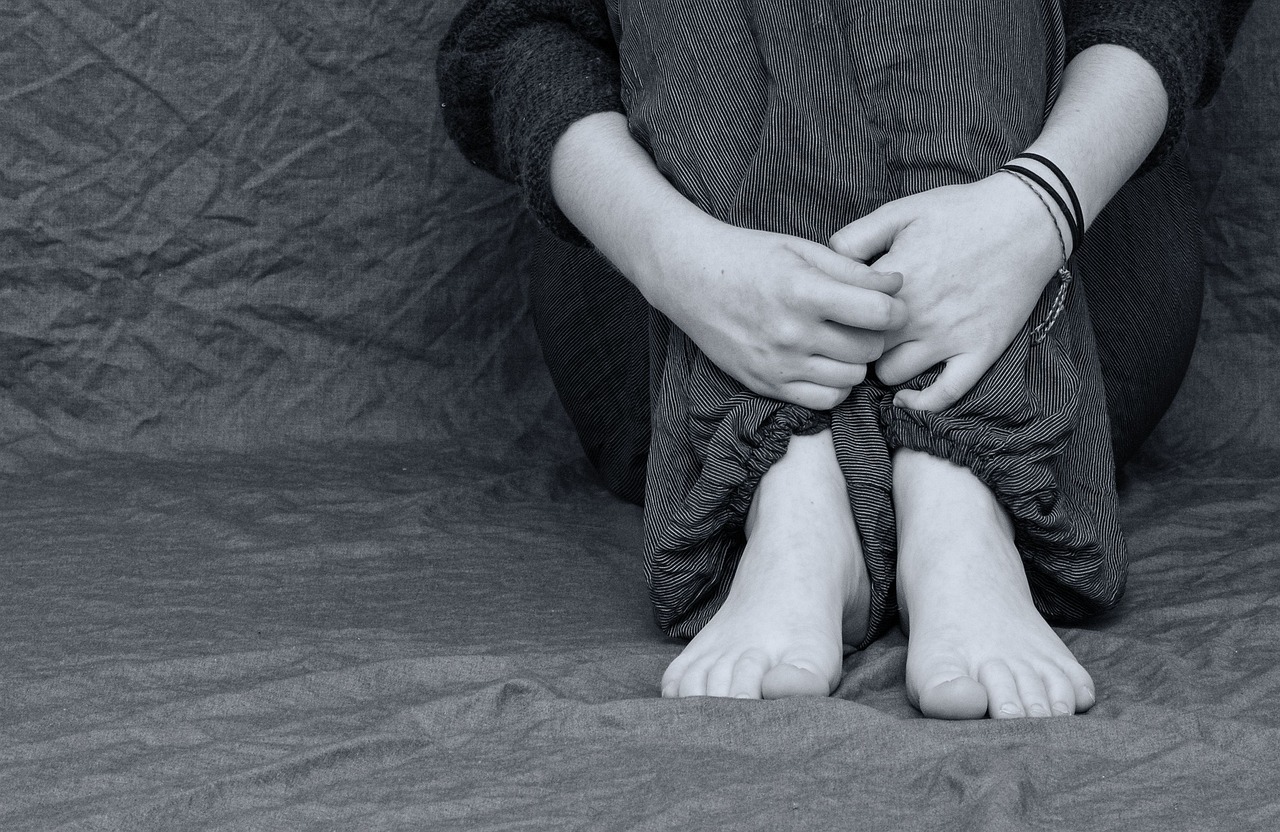
The issue of suicide among beloved children
The rising number os suicides among children and adolescents in Japan is a serious social issue.
10歳代の自殺問題
近年、10代の若者の自殺が深刻な社会問題となっています。文部科学省の調査によると、令和4年度に自殺した小・中・高校生は411人に上り、前年度から43人増加しました。
厚生労働省と警察庁の調査では、2022年の10代の自殺者数は796人で、前年から6.3%増加しています。
これは、1日に平均2人以上の子どもが自ら命を絶っている計算になります。
内閣府の「令和4年版 子供・若者白書」によると、2020年の15~19歳の死因の約半数が自殺であり、若者の死因として最も多いものです。
自殺の背景には、様々な要因が複雑に絡み合っていると考えられます。
文部科学省の調査では、自殺の原因・動機として「不明」が最も多く、全体の62.0%を占めています。
その他、「家庭不和」「進路問題」「両親の叱責」「友人関係の悩み」などが挙げられますが、いずれも子どもの自殺の背景は一様ではありません。
子どもの自殺を防ぐためには、早期発見・早期対応が重要です。周囲の大人は、子どもの小さな変化に気づき、寄り添い、話を聞くことが大切です。また、子ども自身も、悩みを抱え込んだり、一人で抱え込んだりせずに、信頼できる大人に相談することが大切です。
The problem of Suicide Among Teenagers
A survey by the Ministry of Health, Labour and Welfare and the National Police Agency found that the number of suicides among teenagers in 2022 was 796, an increase of 6.3% from the previous year. This means that an average of more than two children take their own lives every day.
According to the Cabinet Office’s 2022 White Paper on Children and Young People, suicide accounted for about half of all deaths among 15- to 19-year-olds in 2020, making it the leading cause of death among young people. It is thought that various factors are complexly intertwined in the background of suicide.
In the MEXT survey, “unknown” was the most common cause or motive for suicide, accounting for 62.0% of the total.
Other factors include “family discord,” “problems with future career paths,” “scolding by parents,” and “worries about friendships,” but the background of children’s suicide is not uniform.
Early detection and early response are important to prevent child suicide. It is important for adults around children to notice small changes in children, to be there for them, and to listen to them. It is also important for children themselves to talk to a trusted adult instead of bottling up their worries or holding them in alone.”
Additional Information:
It is important to note that suicide is a complex issue with no single cause.
If you or someone you know is struggling with suicidal thoughts, please seek help. You can contact a suicide prevention hotline or mental health professional.
Here are some resources that can help:
・The Japan Suicide Prevention Center: https://jscp.or.jp/
・Inochi no Denwa(Lifeline): https://www.inochinodenwa.org/
I hope this information is helpful.
表題タイトルに戻る
青少年の自殺の原因
青少年自殺の原因は複雑です。
1・ 学校の問題
「虐めによる自殺」
深刻な虐めは、青少年の自尊心を著しく傷つけ、絶望感や孤立感を深めす。
「学業不振」
成績へのプレッシャーや将来への不安は、大きなストレスとなります。
「友人関係の悩み」
仲間外れ、孤立、人間関係のトラブルなども、精神的な負担となります。
2・家庭問題
家庭不和:親の不仲、虐待、ネグレクトなどは、子どもの心に深い傷を残ます。
「経済的問題」
貧困や経済的な不安は、家庭内の緊張を高め、子どもの精神状態にも影響を与えます。
「親からの過度な期待や干渉」
親の期待に応えられないことへのプレッシャーや、過度な干渉によるストレスも要因となります。
3・社会的な問題
SNSでの誹謗中傷:インターネット上での誹謗中傷やいじめは、匿名性が高く、被害者が孤立しやすい特徴があります。
「将来への不安」
就職難や社会情勢の不安定さなど、将来への不安は、若者の精神的な負担となります。
「メディアの影響」
自殺に関する報道や、自殺を美化するような表現は、自殺を誘発する可能性があります。
4・精神疾患
精神疾患による鬱病、不安障害などの精神疾患は、自殺のリスクを高めます。
発達障害:発達障害による生きづらさや周囲とのギャップが、精神的な負担となる場合があります。
性的指向や性自認に関する悩み:周囲に相談できずに孤立してしまうケースがあります。
5・死にたい気持ちの伝染
著名人の自殺報道に影響されたり、身近な人が自殺したことに影響されたりする場合があります。
その他複合的な要因:上記の要因が複雑に絡み合っている場合もあります。
重要な注意点:これらの要因は、あくまで一般的な傾向であり、個々のケースは大きく異なります。
自殺の原因は特定が難しく、多くの場合、複数の要因が複雑に絡み合っていますので、自殺のサインにいち早く気づき、適切な支援につなげることが重要です。もし、あなたが悩みを抱えている場合は、一人で抱え込まずに、相談窓口や医療機関に相談してください。
相談窓口
・ いのちの電話:0570-783-556
・よりそいホットライン:0120-279-338
・厚生労働省の相談窓口:自殺対策|厚生労働省
これらの情報は、青少年自殺の複雑な性質を理解し、予防と対策に役立てるためのものです。
6・青少年の命の考え方と取組
青少年の命の考え方は、成長過程で様々な経験や価値観の形成によって大きく影響を受けます。
「自己肯定感と自己価値」
青少年期は、自己肯定感や自己価値が確立されていく重要な時期です。周囲との比較や評価、SNSなどによる情報過多な環境は、自己肯定感を揺るがし、自己価値を低く見積もってしまうことがあります。そして、「自分は価値がない」「生きている意味がない」といった考えに繋がりやすく、命を軽視してしまう危険性も高まります。
「将来への希望と不安」
進学、就職、人間関係など、将来への期待と同時に、大きな不安を抱えやすい時期でもあります。
社会情勢の不安定さや将来への不確実性から、希望を見出すことが難しくなり、絶望感や無力感に苛まれることがあり、「未来に希望がない」「生きていても良いことがない」といった考えは、命を諦めてしまうことに繋がる可能性があります。
「周囲との関係性と孤立」
家族や友人との関係性は、青少年の心の安定に大きく影響します。虐め、虐待、孤立など、周囲との関係における困難は、心に深い傷を残し、命を軽視してしまう要因となります。そして、「誰もわかってくれない」「一人ぼっちだ」という孤独感は、命を絶つという選択に繋がりかねません。
「死生観の未熟さ」
青少年期は、死について深く考える機会が少なく、死生観が十分に確立されていないことがあります。
死を現実のものとして捉えられず、衝動的な行動に繋がりやすい傾向があります。「死んだら楽になる」「消えてしまいたい」といった考えは、命の尊さを軽視してしまう危険性があります。
「命の尊さの再確認させる」
青少年期は、命の尊さを改めて認識し、生きる意味を見出すことができる時期でもあり、他者との繋がりや社会貢献を通して、自己肯定感や自己価値を高めることができます。困難を乗り越える経験を通して、生きる力や希望を育むことができます。
7・ 青少年を取り巻く大人たちの役割
青少年の命を守るためには、周囲の大人たちが彼らの声に耳を傾け、寄り添うことが重要です。
悩みを抱えている青少年に対して、適切な支援を提供し、孤立を防ぐ必要があります。命の大切さを伝え、生きる希望を育むための教育や啓発活動も重要です。もし、周りに悩んでいる青少年がいたら、話を聞いて寄り添い、専門機関への相談を促すことが大切です。
8・青少年の鬱病と自殺の実態
青少年のうつ病と自殺は、深刻な社会問題です。以下に、その実態と関連情報についてまとめました。
「青少年の自殺に於ける日本の現状」
日本の若者の死因の第1位は自殺です。厚生労働省の調査によると、若年層の自殺者数は依然として高い水準にあります。特に、近年では女子生徒の自殺が増加傾向にあります。
「主な要因」
学校での問題(いじめ、人間関係、学業不振など)が大きな要因の一つです。 家庭環境の問題、友人関係、将来への不安なども影響し SNSの普及による影響も指摘されています。そして、コロナ禍による生活の変化や不安も要因の一つと考えられます。
「青少年のうつ病の現状」
関連性:うつ病は自殺の大きなリスク要因です。青少年のうつ病は、早期発見と適切な治療が重要です。
症状:気分の落ち込み、興味や意欲の低下、睡眠障害、食欲不振などが見られます。集中力や注意力の低下、イライラ感、焦燥感なども現れ身体的な症状が現れることもあります。
注意点:青少年のうつ病は、大人とは異なる症状を示すことがありますので、周囲の大人が注意深く見守り、早期発見に努めることが大切です。
対応策:早期発見・早期対応。学校や家庭での早期発見と、専門機関への相談が重要であり、スクールカウンセラーや専門医との連携が不可欠です。
相談窓口の活用:厚生労働省の「まもろうよこころ」などの相談窓口や自治体やNPO法人相談窓口・SNSを活用した相談窓口も増えています。
「周囲のサポート」
家族や友人など、周囲のサポートが重要です。悩みを抱えている青少年の声に耳を傾け、孤立させないことが大切です。
虐め対策:学校現場での虐め対策の強化が必要です。早期発見、早期対応、そしていじめを許さない環境づくりが重要です。
「関連情報」
厚生労働省のウェブサイトでは、自殺対策に関する情報や相談窓口が掲載されています。文部科学省のウェブサイトでは、いじめ対策や学校での相談体制に関する情報が掲載されています。認定NPO法人フリー・ザ・チルドレン・ジャパンなどのNPO法人が自殺問題に関する情報を発信しています。
もし、お子様や周りの人が悩んでいるようでしたら、専門機関への相談を検討してください。
9・我が子を自殺で失った親の悲しみ
お子様を亡くされた親御様の心情は、計り知れないほど深く、複雑なものです。以下に、その心情のいくつかの側面をまとめました。
「 喪失感と悲嘆」
深い悲しみ:愛するお子様を失った悲しみは、言葉では表現できないほど深く、長く続くものです。
喪失感:お子様の存在がなくなったことによる喪失感は、日常生活のあらゆる場面で感じられ、常に心の奥底に痛みを感じます。
無力感:お子様の死に対して何もできなかったという無力感に苛まれることがあります。
「 混乱と苦悩」
現実感の欠如:お子様が亡くなったという事実を受け入れられず、現実感がなくなり、混乱することがあります。
自責の念:「もっと何かできたのではないか」「自分のせいではないか」と自らを責めてしまうことがあります。
怒り:お子様を奪われたことへの怒りや、不公平感を感じることがあります。
孤独感:周囲に理解してもらえないと感じ、孤独感を深めることがあります。
「様々な感情の波」
悲しみ、怒り、後悔、寂しさ、不安など、様々な感情が波のように押し寄せ、心が休まる時がありません。感情の起伏が激しく、時に何も感じなくなることもあります。
「その他の心情」
生きる意味の喪失:お子様を失ったことで、生きる意味を見失ってしまうことがあります。
将来への不安:今後の生活や、残された家族のことに不安を感じることがあります。
思い出との葛藤:お子様の思い出に浸りたい一方で、思い出が辛すぎて向き合えないこともあります。
「周囲のサポート」
親御様の心情は、時間とともに変化していくものです。周囲の人は、焦らず、寄り添い、話を聞いてあげることが大切です。専門家によるカウンセリングや、同じ経験をした親御様との交流も、心の支えとなることがあります。
「関連情報」
子供を亡くした悲しみに沈んでいる方へ 死別の悲しみを乗り越える5つの方法-浄土真宗親鸞会:https://shinrankai.jp/article/3069
子どもとの死別を乗り超えるには?-マイベストプロ:https://mbp-japan.com/tokyo/angelqp/column/1365334/
子どもを亡くして生きるのが辛いあなたへ【前を向くために今できることとは】:https://yuuuuuchan.com/maewo-mukutameni/
お子様を亡くされた親御様は、深い悲しみの中にいますが、決して一人ではありません。周りのサポートを受けながら、少しずつ前に進んでいくことができます。
自殺統計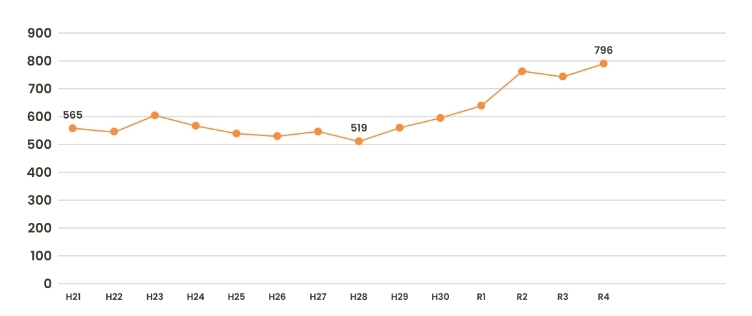

Causes of Youth Suicide
The causes of youth suicide are complex.
1. School Problems
“Suicide due to bullying”
Severe bullying significantly damages a young person’s self-esteem, deepening feelings of despair and isolation.
“Academic underachievement”
Pressure regarding grades and anxiety about the future can cause significant stress.
“Worries about friendships”
Being excluded, isolated, or experiencing interpersonal troubles can also be a mental burden.
2. Family Problems
Family discord:
Parental discord, abuse, and neglect can leave deep scars on a child’s heart.
“Economic problems”
Poverty and economic anxiety can increase tension within the family and affect the child’s mental state.
“Excessive expectations or interference from parents”
Pressure from not being able to meet parental expectations and stress from excessive interference can also be contributing factors.
3. Social Problems
Cyberbullying on social media:
Cyberbullying and online harassment are highly anonymous, which can easily lead to victim isolation.
“Anxiety about the future”
Anxiety about the future, such as difficulty finding employment and instability in social conditions, can be a mental burden for young people.
“Media influence”
Reports about suicide and expressions that glorify suicide can induce suicidal behavior.
4. Mental Health Issues
Mental illnesses:
Mental illnesses such as depression and anxiety disorders increase the risk of suicide.
Developmental disorders:
Difficulties in life and gaps with those around them due to developmental disorders can be a mental burden.
Worries about sexual orientation or gender identity:
There are cases where individuals become isolated because they cannot consult with those around them.
5. Contagion of Suicidal Thoughts
There are cases where individuals are influenced by reports of celebrity suicides or by the suicide of someone close to them.
Other complex factors:
The above factors can also be intertwined in a complex manner.
Important Note:
These factors are only general tendencies, and individual cases vary greatly.
It is difficult to identify the cause of suicide, and in many cases, multiple factors are complexly intertwined. Therefore, it is important to notice the signs of suicide as early as possible and connect individuals to appropriate support.
If you are struggling with worries, please do not keep them to yourself; consult with a counseling service or medical institution.
Consultation Services
Inochi no Denwa (Lifeline): 0570-783-556
Yorisoi Hotline: 0120-279-338
Ministry of Health, Labour and Welfare Consultation Service: Suicide Countermeasures | Ministry of Health, Labour and Welfare
This information is intended to help understand the complex nature of youth suicide and to assist in prevention and countermeasures.
6. Adolescents’ Views on Life and Related Initiatives
Adolescents’ views on life are significantly influenced by various experiences and the formation of values during their developmental process.
“Self-Esteem and Self-Worth”
Adolescence is a crucial period for establishing self-esteem and self-worth. Comparisons and evaluations with others, as well as an information-overloaded environment due to social media, can shake self-esteem and lead to underestimating self-worth. This can easily lead to thoughts like “I am worthless” or “There is no meaning in living,” increasing the risk of trivializing life.
“Hope and Anxiety for the Future”
This is also a period when adolescents tend to harbor great anxiety along with expectations for the future, such as further education, employment, and relationships. The instability of social conditions and uncertainty about the future can make it difficult to find hope, leading to feelings of despair and helplessness. Thoughts like “There is no hope for the future” or “There is nothing good in living” can lead to giving up on life.
“Relationships with Others and Isolation”
Relationships with family and friends greatly affect adolescents’ mental stability. Difficulties in relationships, such as bullying, abuse, and isolation, can leave deep scars on the heart and contribute to trivializing life. Feelings of loneliness, such as “No one understands me” or “I am all alone,” can lead to choosing to end one’s life.
“Immaturity in Views on Life and Death”
Adolescents often have limited opportunities to think deeply about death, and their views on life and death may not be fully established. They tend to have difficulty perceiving death as a reality, which can lead to impulsive actions. Thoughts like “Death would be easier” or “I want to disappear” can trivialize the value of life.
“Reaffirming the Preciousness of Life”
Adolescence is also a period when individuals can re-recognize the preciousness of life and find meaning in living. By connecting with others and contributing to society, they can enhance their self-esteem and self-worth. Experiences of overcoming difficulties can foster the strength to live and hope.
7. The Role of Adults Surrounding Adolescents
To protect the lives of adolescents, it is crucial for adults around them to listen to their voices and support them. It is necessary to provide appropriate support to adolescents who are struggling and to prevent isolation. Education and awareness activities that convey the importance of life and foster hope for living are also important. If you know an adolescent who is struggling, it is important to listen to them, support them, and encourage them to seek advice from specialized institutions.
8. The Reality of Depression and Suicide Among Adolescents
Depression and suicide among adolescents are serious social problems. The following is a summary of the current situation and related information.
“The Current Situation of Adolescent Suicide in Japan”
Suicide is the leading cause of death among young people in Japan. According to a survey by the Ministry of Health, Labour and Welfare, the number of suicides among young people remains high. In particular, there has been an increasing trend in suicides among female students in recent years.
“Main Factors”
Problems at school (bullying, relationships, academic underachievement, etc.) are a major factor.
Problems in the home environment, friendships, and anxiety about the future also have an impact.
The influence of the spread of social media is also pointed out.
Changes and anxieties in life due to the COVID-19 pandemic are also considered to be factors.
“The Current Situation of Adolescent Depression”
Correlation: Depression is a major risk factor for suicide. Early detection and appropriate treatment of depression in adolescents are crucial.
Symptoms: Symptoms include depressed mood, decreased interest and motivation, sleep disorders, and loss of appetite. Decreased concentration and attention, irritability, and anxiety may also appear, and physical symptoms may also manifest.
Points to Note: Adolescent depression can present with different symptoms than adult depression, so it is important for adults around them to observe carefully and strive for early detection.
Countermeasures: Early detection and early response are essential. Early detection at school and home, and consultation with specialized institutions are important, and cooperation with school counselors and specialists are indispensable.
Utilization of Consultation Services: There has been an increase in consultation services such as the Ministry of Health, Labour and Welfare’s “Mamorou yo Kokoro” (Let’s Protect Our Hearts) and consultation services by local governments, NPOs, and consultation services using social media.
“Support from Those Around”
Support from those around, such as family and friends, is important. It is important to listen to the voices of adolescents who are struggling and not isolate them.
Bullying Countermeasures: It is necessary to strengthen bullying countermeasures at schools. Early detection, early response, and creating an environment that does not tolerate bullying are important.
“Related Information”
The website of the Ministry of Health, Labour and Welfare provides information on suicide prevention and consultation services.
The website of the Ministry of Education, Culture, Sports, Science and Technology provides information on bullying countermeasures and school consultation systems.
NPOs such as the certified NPO Free the Children Japan provide information on suicide issues.
If your child or someone around you seems to be struggling, please consider consulting with a specialized institution.
9. The Grief of Parents Who Lost Their Child to Suicide
The feelings of parents who have lost their child are immeasurably deep and complex. The following is a summary of some aspects of these feelings.
“Loss and Grief”
Deep Grief: The grief of losing a beloved child is indescribably deep and long-lasting.
Sense of Loss: The sense of loss from the absence of the child is felt in every aspect of daily life, with a constant pain in the depths of the heart.
Helplessness: Parents may be overwhelmed by a sense of helplessness, feeling unable to do anything about their child’s death.
“Confusion and Anguish”
Lack of Reality: Parents may struggle to accept the fact that their child has died, experiencing a lack of reality and confusion.
Self-Blame: They may blame themselves, thinking, “I wonder if I could have done more” or “Was it my fault?”
Anger: They may feel anger at being deprived of their child or feel a sense of unfairness.
Loneliness: They may feel misunderstood by those around them, deepening their sense of loneliness.
“Waves of Various Emotions”
Various emotions, such as sadness, anger, regret, loneliness, and anxiety, surge like waves, leaving no time for the heart to rest. Emotional ups and downs are intense, and at times, they may feel nothing at all.
“Other Feelings”
Loss of Meaning in Life: They may lose their sense of meaning in life after losing their child.
Anxiety about the Future: They may feel anxious about their future life and the remaining family.
Conflict with Memories: While they may want to immerse themselves in memories of their child, the memories may be too painful to face.
“Support from Those Around”
Parents’ feelings change over time. It is important for those around them to be patient, supportive, and listen to them.
Counseling by specialists and interaction with parents who have had similar experiences can provide emotional support.
“Related Information”
To those who are sinking in the grief of losing a child: 5 ways to overcome the grief of bereavement – Jodo Shinshu Shinrankai: https://shinrankai.jp/article/3069
How to overcome the bereavement of a child? – My Best Pro: https://mbp-japan.com/tokyo/angelqp/column/1365334/
To those who are suffering from living after losing a child [What you can do now to move forward]: https://yuuuuuchan.com/maewo-mukutameni/
Parents who have lost their child are in deep grief, but they are not alone. They can move forward little by little with the support of those around them.
薬物乱用 未成年者を薬物から守る

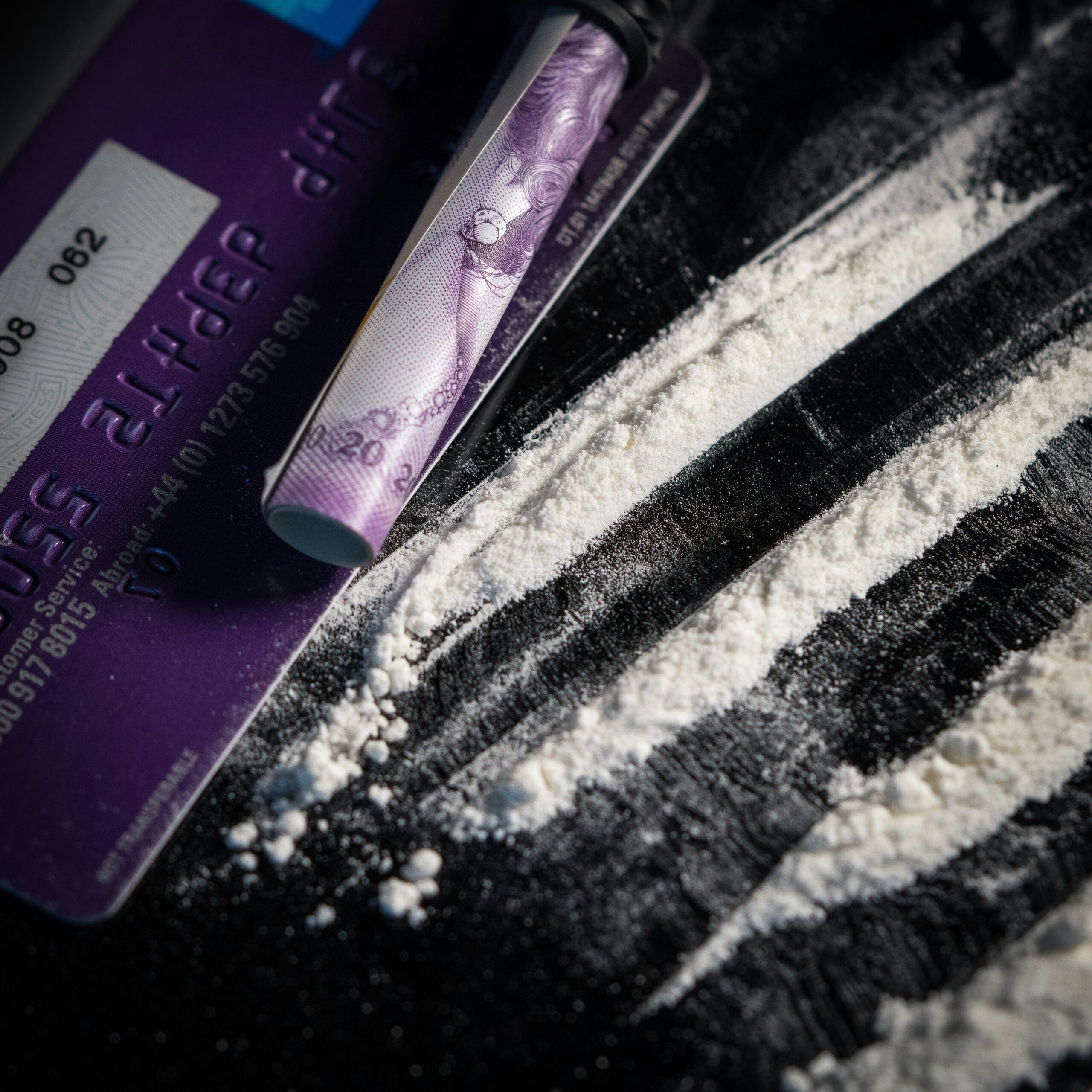
表題タイトルに戻る
青少年の違法薬物に現状について
「青少年の違法薬物乱用」
現状と対策:近年、青少年の間で違法薬物乱用が深刻化しており、憂慮すべき状況です。特に、大麻や危険ドラッグ、市販薬の乱用が顕著です。大麻乱用は若年層を中心に増加し、検挙者数は過去最多を更新しています。インターネットやSNSを通じて容易に入手できる環境が、若者の好奇心や安易な気持ちを助長しています。「大麻は安全」といった誤った情報も拡散されており、危険性の認識不足が深刻です。
「危険ドラッグの脅威」
危険ドラッグは、外見上合法的な商品と区別がつきにくく、若者が安易に手を出す可能性があります。成分が不明確なため、健康被害や死亡事故につながる危険性も高く、インターネットを通じて容易に入手できることから、若者の間に急速に広がっています。
「市販薬の乱用」
10代から20代の間で、医薬品や市販薬のオーバードーズが急増し、社会問題となっています。学校や職場、家庭における悩みなどを抱える若者が、手軽に入手できる市販薬に依存し、現実逃避を図るケースが多く見られます。
「背景にある要因」
インターネット・SNSの普及:違法薬物の情報や入手方法が容易に入手可能となり、若者の好奇心を刺激しています。
ストレスや不安の増大:学業、人間関係、将来への不安など、若者が抱えるストレスが増加しており、違法薬物や市販薬による一時的な現実逃避に繋がっています。
規範意識の低下:違法薬物に対する危険性の認識不足や安易な気持ちが、規範意識の低下を招いています。一部の国における大麻合法化の影響で、「大麻は安全」という誤った認識を持つ若者が増加しています。
「対策の重要性」
早期薬物教育と啓発活動:学校、家庭、地域社会が連携し、違法薬物の危険性や正しい知識を早期から教育することが重要です。
相談体制の強化:若者が悩みを相談できる窓口を充実させ、早期発見・早期対応につなげるとともに、医療機関や専門機関との連携を強化する必要があります。
取締りの強化:インターネットやSNSを通じた違法薬物の売買を取り締まり、関係機関と連携して水際対策を強化することが重要です。
青少年を違法薬物の脅威から守るためには、社会全体での対策が不可欠です。
The Current State of Illegal Drug Use Among Young People
llegal Drug Abuse Among Young People”
Current Situation and Countermeasures: In recent years, illegal drug abuse among young people has become a serious and alarming situation. There is a notable increase in the abuse of cannabis, dangerous drugs, and over-the-counter medications. Cannabis abuse is on the rise, particularly among young people, and the number of arrests has reached a record high. The ease of access through the internet and social media is fueling young people’s curiosity and careless attitudes. Misinformation such as “cannabis is safe” is also spreading, leading to a serious lack of awareness about its dangers.
“The Threat of Dangerous Drugs”
Dangerous drugs are difficult to distinguish from seemingly legal products, making it easy for young people to try them. Due to their unclear composition, they pose a high risk of health damage and fatal accidents. Their easy availability online has contributed to their rapid spread among young people.
“Over-the-Counter Drug Abuse”
Overdosing on prescription and over-the-counter medications is rapidly increasing among teenagers and young adults, becoming a social problem. Many young people, burdened with problems at school, work, or home, turn to easily accessible over-the-counter drugs as a form of escapism.
“Underlying Factors”
Spread of the Internet and Social Media: Information and methods for obtaining illegal drugs are readily available, stimulating young people’s curiosity.
Increased Stress and Anxiety: Young people are experiencing increased stress related to academics, relationships, and future uncertainties, leading them to seek temporary escape through illegal drugs and over-the-counter medications.
Decline in Ethical Awareness: A lack of awareness about the dangers of illegal drugs and careless attitudes are contributing to a decline in ethical awareness. The legalization of cannabis in some countries has led to an increase in young people who mistakenly believe that “cannabis is safe.”
“Importance of Countermeasures”
Early Drug Education and Awareness Campaigns: It is crucial for schools, families, and communities to collaborate in providing early education about the dangers of illegal drugs and accurate information.
Strengthening Consultation Systems: Enhancing counseling services for young people to address their concerns, facilitating early detection and intervention, and strengthening collaboration with medical and specialized institutions are necessary.
Strengthening Law Enforcement: It is important to crack down on the sale of illegal drugs through the internet and social media, and to strengthen border control in cooperation with relevant agencies.
It is essential for society as a whole to take action to protect young people from the threat of illegal drugs.
違法薬物の入手ルートについて
違法薬物の入手経路は多岐にわたり、状況によって異なります。主な入手経路は以下のとおりです。
「国内での入手方法」
友人・知人からの入手:親しい友人や知人を通じて入手するケースが多く、特に若年層において顕著です。
密売人からの入手:繁華街や特定の場所で密売人から直接購入するケースです。
インターネットやを利用した入手:匿名掲示板やSNS、ダークウェブなどを通じて売買が行われるケースが増加傾向にあります。例として、SNSの匿名グループ内での売買、暗号化されたメッセージアプリを利用した取引などが挙げられます。
「海外からの入手ルート」
密輸:航空機や船舶、国際郵便などを利用した密輸が行われます。
インターネットを通じた個人輸入:海外のウェブサイトを通じて個人輸入するケースがあります。
「違法薬物の危険性」
違法薬物は、心身に深刻な悪影響を及ぼす可能性があります。具体的には、以下のような危険性があります。
依存症:一度使用すると、やめたくてもやめられなくなることがあります。
精神疾患:幻覚、妄想、錯乱などの精神症状を引き起こすことがあります。
身体疾患:臓器障害、呼吸困難、心停止などを引き起こすことがあります。
過剰摂取(オーバードーズ):最悪の場合、死に至る可能性があります。
「違法薬物に関する注意点」
違法薬物の売買や所持は法律で厳しく禁止されており、処罰の対象となり、インターネットやSNSを利用した違法薬物の売買は、匿名性が高い反面、警察による捜査も強化されています。興味本位や軽い気持ちで使用した場合でも、依存症になる危険性があります。もし、違法薬物の使用や入手に関して悩んでいる場合は、一人で悩まずに、専門機関に相談してください。
「相談窓口」
薬物乱用防止相談窓口:各都道府県の保健所や精神保健福祉センターなどで相談を受け付けています。
麻薬取締部:違法薬物に関する情報提供や相談を受け付けています。
違法薬物に関する情報は、厚生労働省や警察庁のウェブサイトでも確認できます。
「その他」
違法薬物の種類によっては、一度の使用でも重大な健康被害を引き起こす可能性があります。違法薬物の使用は、周囲の人々にも悪影響を及ぼす可能性があります。上記の情報が、違法薬物に関する理解を深める一助となれば幸いです。
Illegal Drug Acquisition Routes
The routes for obtaining illegal drugs vary widely and depend on the situation. The main acquisition routes are as follows:
Domestic Acquisition Methods:
・ Acquisition from friends and acquaintances: This is a common case, especially among young people, where drugs are obtained through close friends and acquaintances.
・ Acquisition from dealers: This involves purchasing directly from dealers in downtown areas or specific locations.
・ Acquisition using the Internet and social media: There is a growing trend of buying and selling through anonymous bulletin boards, social media, and the dark web. Examples include transactions within anonymous groups on social media and transactions using encrypted messaging apps.
Overseas Acquisition Routes:
・ Smuggling: Smuggling is carried out using aircraft, ships, international mail, etc.
・ Personal importation via the Internet: In some cases, drugs are personally imported through overseas websites.
Dangers of Illegal Drugs:
Illegal drugs can have serious adverse effects on the mind and body. Specifically, there are the following dangers:
・ Addiction: Once used, it may become impossible to stop even if you want to.
・ Mental illness: Can cause mental symptoms such as hallucinations, delusions, and confusion.
・ Physical illness: Can cause organ damage, respiratory distress, cardiac arrest, etc.
・ Overdose: In the worst case, it can lead to death.
Precautions Regarding Illegal Drugs:
The sale, purchase, and possession of illegal drugs are strictly prohibited by law and are subject to punishment. While the anonymity of illegal drug transactions over the Internet and social media may be high, police investigations are also being strengthened. There is a risk of addiction even if used out of curiosity or on a whim. If you are concerned about the use or acquisition of illegal drugs, do not hesitate to seek help from a specialized organization.
Consultation Services:
・ Drug Abuse Prevention Consultation Services: Consultations are available at public health centers and mental health and welfare centers in each prefecture.
・ Narcotics Control Department: Provides information and consultations on illegal drugs.
Information on illegal drugs can also be found on the websites of the Ministry of Health, Labour and Welfare and the National Police Agency.
Other:
Depending on the type of illegal drug, even a single use can cause serious health damage. The use of illegal drugs can also have a negative impact on those around you. We hope that the above information will help you deepen your understanding of illegal drugs.
Additional points:
・ When translating medical or legal information, accuracy is paramount.
・ It’s important to convey the severity of the dangers associated with illegal drug use.
・ The information provided is for educational purposes and should not be considered a substitute for professional advice.
青少年の薬物依存の治療について
青少年の薬物依存は、心身の発達に深刻な影響を与える可能性があり、早期の発見と適切な治療が重要です。以下に、青少年の薬物依存の治療について詳しく説明します。
1・青少年の薬物依存の特徴
「発達段階における影響」
青少年の脳は発達途中であり、薬物の影響を受けやすく、依存症になりやすい傾向があります。
「心理的な要因」
ストレス、不安、うつなどの心理的な問題を抱えている場合、薬物に依存しやすいことがあります。
「周囲の環境」
家庭や学校、友人関係など、周囲の環境も薬物依存に影響を与える可能性があります。
2・治療の種類
青少年の薬物依存の治療は、大きく分けて以下の3つの段階で行われます。
「解毒」
薬物の使用を中止し、体から薬物を排出する段階です。医療機関で医師の管理下で行われることが望ましいです。
「リハビリテーション」
薬物依存からの回復を目指し、心理療法やグループ療法などを行います。
「再発防止」
再発を防ぐために、継続的な支援やアフターケアを行います。
3・具体的な治療方法
「認知行動療法」
薬物への欲求や衝動をコントロールする方法を学び、再発を防ぎます。
「家族療法」
家族全体で薬物問題に取り組み、青少年の回復を支援します。
「グループ療法」
同じような問題を抱える仲間と交流し、互いに支え合いながら回復を目指します。
「薬物療法」
必要に応じて、抗うつ薬や抗不安薬などの薬物を使用します。
4・相談窓口
精神科・心療内科:薬物依存の専門的な治療を受けることができます。
保健所・精神保健福祉センター:相談や情報提供、医療機関の紹介などを行っています。
薬物依存者支援施設:民間の支援団体が運営する施設で、相談やリハビリテーションを行っています。
5・家族の役割
「早期発見」
青少年の変化に気づき、早期に相談することが大切です。
「適切な対応」
頭ごなしに叱るのではなく、冷静に話を聞き、専門機関への相談を促しましょう。
「継続的な支援」
青少年の回復には、家族の継続的な支援が不可欠です。
6・薬物依存に関する情報
厚生労働省:薬物乱用対策:https://www.mhlw.go.jp/seisakunitsuite/bunya/kenkou_iryou/iyakuhin/yakubutsuranyou_taisaku/
国立研究開発法人 国立精神・神経医療研究センター 精神保健研究所 薬物依存研究部:https://www.ncnp.go.jp/nimh/yakubutsu/
青少年と家族だけで抱え込まず、専門機関や支援団体に相談し、適切な支援を受けることが重要です。
Treatment for Adolescent Drug Addiction
1. Characteristics of Adolescent Drug Addiction
Effects During Developmental Stages:
The adolescent brain is still developing, making it more susceptible to the effects of drugs and increasing the likelihood of addiction.
Psychological Factors:
Adolescents with psychological issues such as stress, anxiety, or depression are more prone to drug dependence.
Surrounding Environment:
Factors such as family, school, and peer relationships can influence drug addiction.
- Types of Treatment
Treatment for adolescent drug addiction is broadly divided into the following three stages:
Detoxification:
This stage involves stopping drug use and eliminating drugs from the body. It is best conducted under the supervision of a physician at a medical facility.
Rehabilitation:
This stage aims to recover from drug dependence and includes psychotherapy and group therapy.
Relapse Prevention:
This stage involves ongoing support and aftercare to prevent relapse.
- Specific Treatment Methods
Cognitive Behavioral Therapy (CBT):
This method teaches how to control drug cravings and impulses to prevent relapse.
Family Therapy:
This approach involves the entire family in addressing drug problems and supporting the adolescent’s recovery.
Group Therapy:
This method allows individuals with similar problems to interact and support each other in their recovery.
Pharmacotherapy:
Medications such as antidepressants and anti-anxiety drugs are used as needed.
- Consultation Services
Psychiatry/Psychosomatic Medicine Clinics:
These clinics provide specialized treatment for drug addiction.
Public Health Centers/Mental Health and Welfare Centers:
These centers offer consultation, information, and referrals to medical institutions.
Drug Addiction Support Facilities:
These facilities, operated by private support organizations, provide consultation and rehabilitation.
- The Role of the Family
Early Detection:
It is important to notice changes in adolescents and seek consultation early.
Appropriate Response:
Instead of scolding, calmly listen and encourage consultation with specialized institutions.
Continuous Support:
Ongoing family support is essential for the adolescent’s recovery.
- Information on Drug Addiction
Ministry of Health, Labour and Welfare: Measures Against Drug Abuse: https://www.mhlw.go.jp/seisakunitsuite/bunya/kenkou_iryou/iyakuhin/yakubutsuranyou_taisaku/
National Institute of Mental Health, National Center of Neurology and Psychiatry: Department of Drug Dependence Research: https://www.ncnp.go.jp/nimh/yakubutsu/
It is important for adolescents and their families not to deal with this issue alone, but to seek consultation with specialized institutions and support organizations for appropriate assistance.
少年院で薬物と向き合う
少年院では、薬物乱用による非行を犯した少年たちに対し、以下のような多角的な支援が行われています。
1・薬物乱用防止教育
薬物に関する正しい知識の習得:薬物の危険性や依存性について学びます。
再乱用防止のためのスキル習得:誘惑への対処法やストレス管理などを学びます。
自尊感情の向上:自己肯定感を高め、薬物に頼らない生き方を模索します。
2・個別・集団療法
個別カウンセリング:専門家との個別面談を通じて、薬物乱用の背景にある心理的な問題や課題に向き合います。
集団療法:同じ問題を抱える仲間とのグループワークを通じて、互いに支え合い、回復を目指します。
3・社会復帰支援
就労支援:職業訓練や就職活動のサポートを行い、社会復帰後の安定した生活を支援します。
住居支援:帰住先の確保や生活基盤の確立を支援します。
保護者との連携:家族関係の修復や、家庭内でのサポート体制の構築を支援します。
4・医療機関との連携
専門的な医療機関と連携し、必要に応じて薬物依存症の治療や精神科的なケアを提供します。
5・関係機関との連携
保護観察所、児童相談所、医療機関など、関係機関と連携し、少年たちの社会復帰を総合的に支援します。
参考資料
政府広報オンライン:再犯を防止して安全・安心な社会へ:https://www.gov-online.go.jp/useful/article/201406/1.html
薬物と少年事件~現状と保護者や弁護士ができること:https://ik-law.jp/case/hanzai/yakubutsu/
これらの取り組みを通じて、少年たちは薬物依存からの回復を目指し、社会の一員として再び歩み始めるためのサポートを受けます。
Facing Drug Issues in Juvenile Detention Centers
Juvenile detention centers provide multifaceted support for juveniles who have committed offenses related to drug abuse, including:
- Drug Abuse Prevention Education
・ Acquiring accurate knowledge about drugs: Learning about the dangers and addictive properties of drugs.
・ Developing skills to prevent relapse: Learning how to cope with temptations and manage stress.
・ Enhancing self-esteem: Building self-confidence and exploring ways to live without relying on drugs.
- Individual and Group Therapy
・ Individual counseling: Addressing psychological issues and challenges behind drug abuse through one-on-one sessions with experts.
・ Group therapy: Supporting each other and aiming for recovery through group work with peers facing similar problems.
- Social Reintegration Support
・ Employment support: Providing vocational training and job search support to help juveniles establish stable lives after release.
・ Housing support: Assisting with securing housing and establishing a foundation for living.
・ Coordination with guardians: Supporting the restoration of family relationships and building a support system within the home
- Collaboration with Medical Institutions
Collaborating with specialized medical institutions to provide treatment for drug addiction and psychiatric care as needed.
- Collaboration with Related Organizations
Collaborating with related organizations such as probation offices, child consultation centers, and medical institutions to comprehensively support juveniles’ social reintegration.
Reference Materials
・ Government Public Relations Online: Preventing Recidivism for a Safe and Secure Society: https://www.gov-online.go.jp/useful/article/201406/1.html
・ Drugs and Juvenile Cases: Current Situation and What Guardians and Lawyers Can Do: https://ik-law.jp/case/hanzai/yakubutsu/
Through these efforts, juveniles receive support to recover from drug dependence and take steps to rejoin society.
表題タイトルに戻る
違法薬物の種類と心身への影響
日本は、国際的には薬物乱用の少ない国と言われていますが、薬物乱用経験者は少なくとも
約200万人以上いることが分かっています。
特に、大麻取締法違反で検挙される若者が急増する中、薬物乱用の低年齢化も増加しています。
違法薬物は、心身に深刻な影響を与える可能性があり、その種類によって作用やリスクが異なります。以下に、代表的な違法薬物の種類と心身への影響について説明します。
1. 覚醒剤(アンフェタミン、メタンフェタミン)
作用: 中枢神経を興奮させ、高揚感、多幸感、集中力向上などを引き起こします。
心身への影響:
・ 精神依存性が高く、乱用を続けると幻覚、妄想、錯乱などの精神症状が現れることがあります。
・ 心臓や血管に負担をかけ、高血圧、不整脈、心臓発作などを引き起こす可能性があります。
・ 食欲不振、不眠、体重減少などの身体的な影響も現れます。
2. 大麻(マリファナ)
作用: 精神作用成分であるTHCが脳に作用し、リラックス効果、多幸感、感覚の変化などを引き起こします。
心身への影響: 精神依存性が形成される可能性があり、乱用を続けると無気力、集中力低下、記憶障害などが現れることがあります。
・ 呼吸器系に悪影響を及ぼし、気管支炎や肺がんのリスクを高める可能性があります。
・ 精神疾患の発症リスクを高める可能性も指摘されています。
3. 合成麻薬(MDMA、コカインなど)
作用: 脳内の神経伝達物質に作用し、高揚感、多幸感、共感性の向上などを引き起こします。
心身への影響:精神依存性が高く、乱用を続けると抑うつ、不安、パニック障害などの精神症状が現れることがあります。
・ 体温調節機能の異常、脱水症状、腎臓や肝臓への負担など、身体的な危険性も高いです。
・ コカインは、心臓発作や脳卒中を引き起こすリスクがあります。
4. 危険ドラッグ(合成カンナビノイド、合成カチノンなど)
作用: 覚醒剤や大麻に似た作用を持つように合成された薬物ですが、成分や作用は多様で予測が困難です。
心身への影響: 幻覚、妄想、錯乱、痙攣、意識障害など、予測不能で危険な精神症状が現れることがあります。心臓や呼吸器系に深刻な影響を与え、死に至るケースも報告されています。
違法薬物乱用のリスク
・精神疾患の発症・悪化
・身体疾患の発症・悪化
・依存症の形成
・過剰摂取による死亡
・ 社会的な問題(犯罪、失業、家庭崩壊など)
違法薬物は、一度でも使用すると依存症になる可能性があり、心身に深刻なダメージを与える危険性があります。絶対に手を出さないようにしましょう。
もし、薬物使用に関する悩みや不安がある場合は、専門の相談機関に相談してください。
・各都道府県の精神保健福祉センター
・薬物依存症に関する相談窓口
・医療機関(精神科、心療内科)
これらの情報を参考に、違法薬物の危険性について理解を深めてください。
Types of illegal drugs and their effects on the mind and body
While Japan is internationally considered a country with low drug abuse rates, it is estimated that at least 2 million people have experience with drug abuse. In particular, the number of young people arrested for violations of the Cannabis Control Act is rapidly increasing, and the age of drug abuse is also decreasing.
Illegal drugs can have serious effects on the mind and body, and their effects and risks vary depending on the type. The following describes the types of representative illegal drugs and their effects on the mind and body:
- Stimulants (Amphetamine, Methamphetamine)
Effects: Stimulate the central nervous system, causing euphoria, a sense of well-being, and increased concentration.
Effects on the mind and body:
・ Highly psychologically addictive, and continued abuse can lead to mental symptoms such as hallucinations, delusions, and confusion.
・ Puts a strain on the heart and blood vessels, and can cause high blood pressure, arrhythmia, and heart attack.
・ Physical effects such as loss of appetite, insomnia, and weight loss may also occur.
- Cannabis (Marijuana)
Effects: THC, the psychoactive ingredient, acts on the brain, causing relaxation, euphoria, and altered perceptions.
Effects on the mind and body:
・ Can lead to psychological dependence, and continued abuse can lead to apathy, decreased concentration, and memory impairment.
・ Adverse effects on the respiratory system, increasing the risk of bronchitis and lung cancer.
・ Has also been pointed out to increase the risk of developing mental illness.
- Synthetic Narcotics (MDMA, Cocaine, etc.)
Effects: Acts on neurotransmitters in the brain, causing euphoria, a sense of well-being, and increased empathy.
Effects on the mind and body:
・ Highly psychologically addictive, and continued abuse can lead to mental symptoms such as depression, anxiety, and panic disorder.
・ High physical risks, such as abnormal body temperature regulation, dehydration, and strain on the kidneys and liver.
・ Cocaine increases the risk of heart attack and stroke.
- Dangerous Drugs (Synthetic Cannabinoids, Synthetic Cathinones, etc.)
Effects: Synthesized to have effects similar to stimulants and cannabis, but the ingredients and effects are diverse and unpredictable.
Effects on the mind and body:
・ Unpredictable and dangerous mental symptoms such as hallucinations, delusions, confusion, convulsions, and impaired consciousness may occur.
・ Can have serious effects on the heart and respiratory system, and cases of death have been reported.
Risks of Illegal Drug Abuse
・ Development and exacerbation of mental illness
・ Development and exacerbation of physical illness
・ Formation of addiction
・ Death from overdose
・ Social problems (crime, unemployment, family breakdown, etc.)
Illegal drugs can be addictive even after a single use, and there is a risk of serious damage to the mind and body. Never get involved with them.
If you have any concerns or anxieties about drug use, please consult with a specialized counseling organization.
・ Prefectural and municipal mental health and welfare centers
・ Consultation services for drug addiction
・ Medical institutions (psychiatry, psychosomatic medicine)
Please use this information to deepen your understanding of the dangers of illegal drugs.
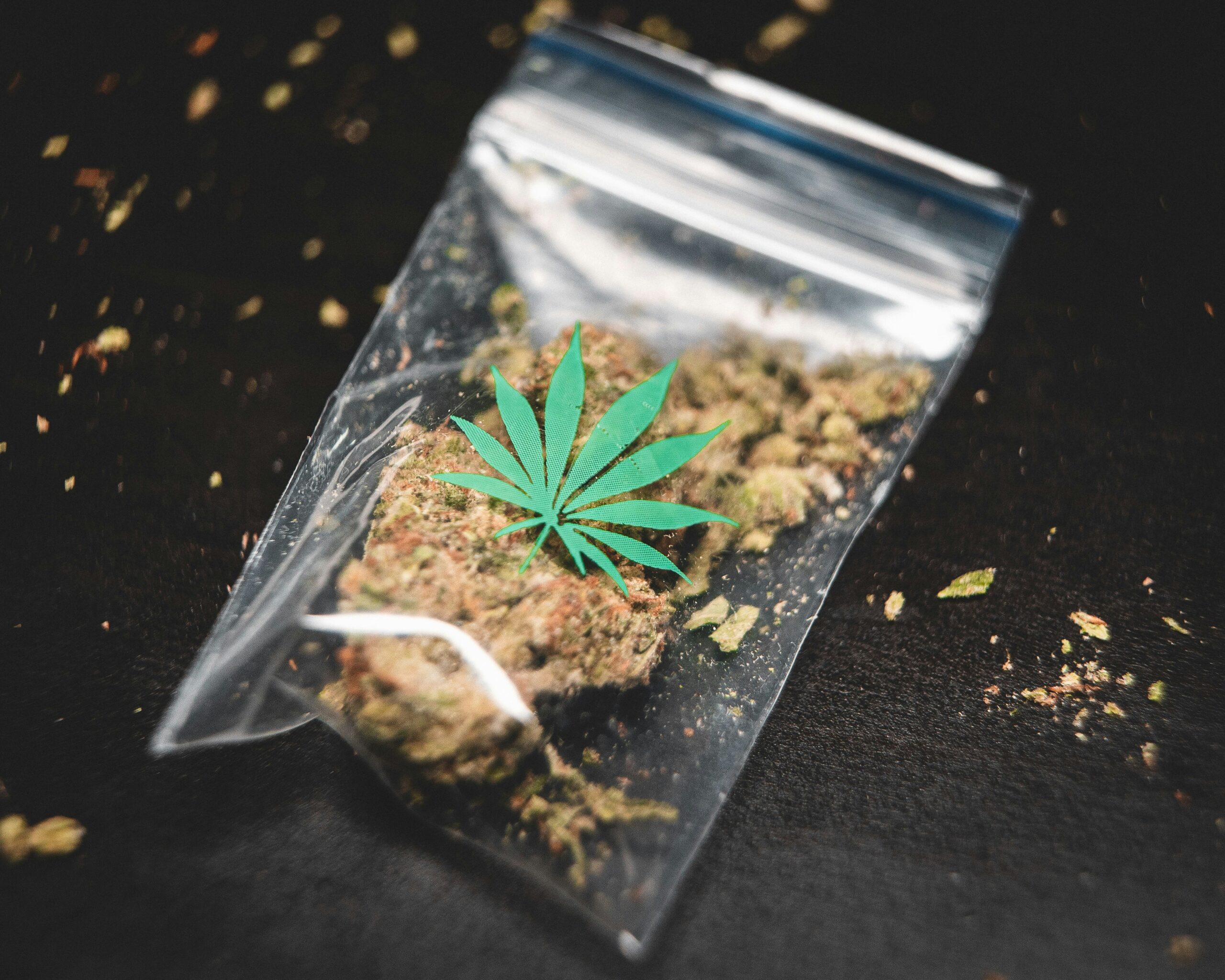


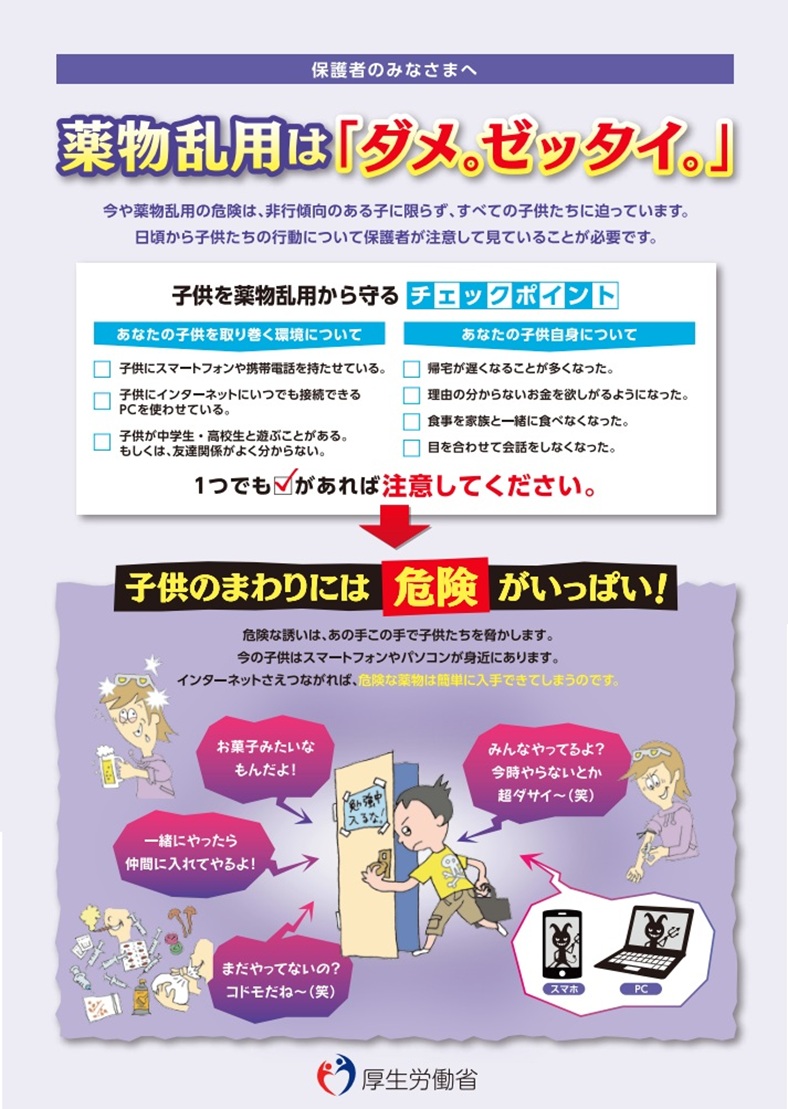
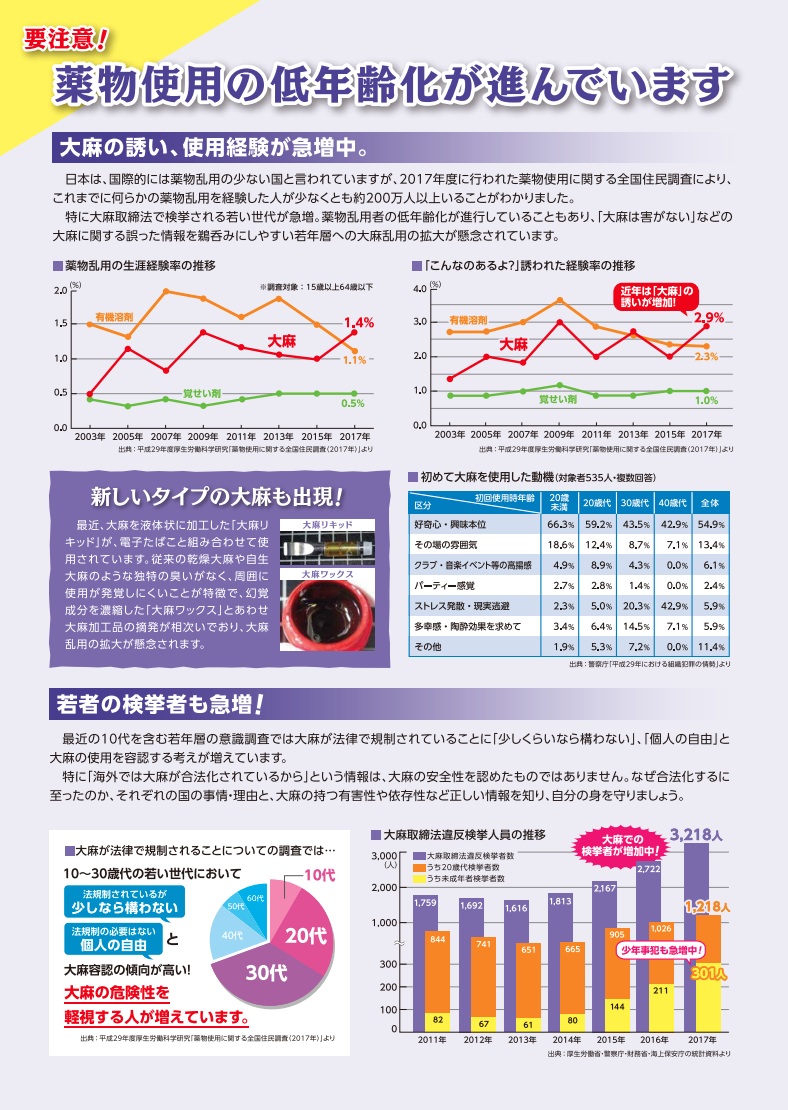
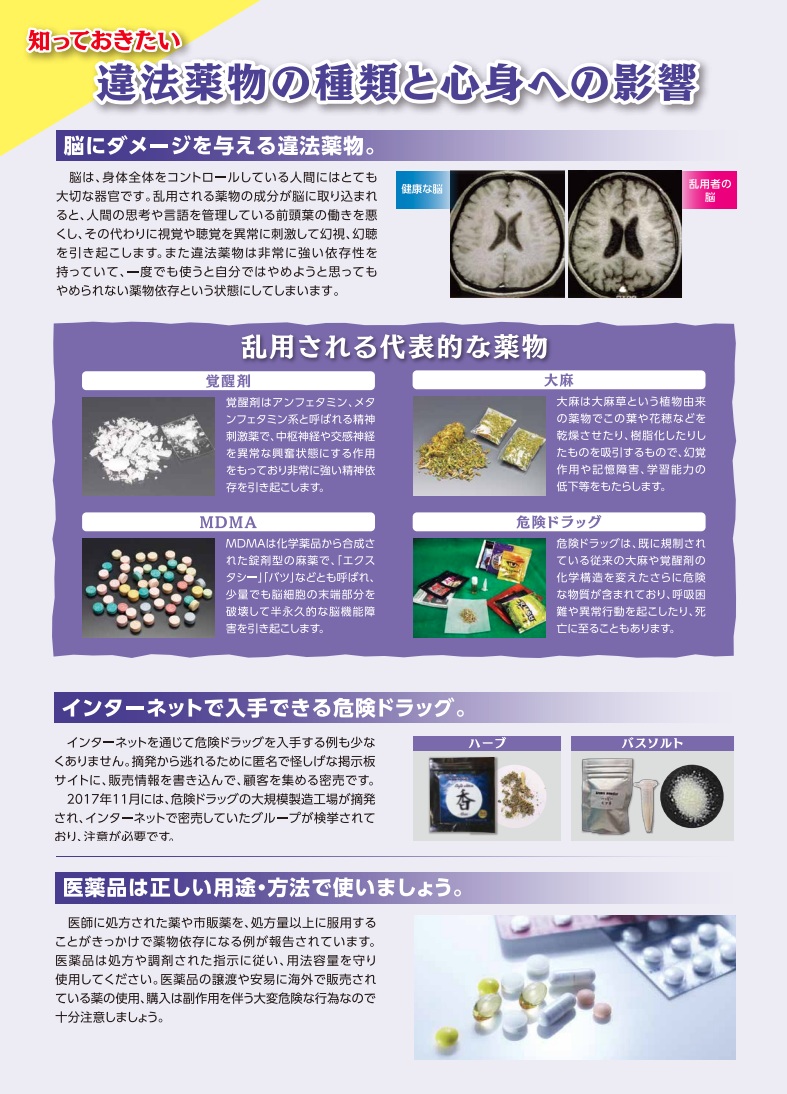
表題タイトルに戻る
闇バイトは犯罪
安易な気持ちで応募すると、以下のような危険な状況に陥る可能性があります。
1. 犯罪に巻き込まれます
・闇バイトは、多くの場合、詐欺、強盗、薬物取引などの犯罪行為に関連しています。
・高額報酬を謳い文句に、犯罪の実行犯や受け子、出し子などとして利用され、逮捕されるリスクがあります。
・犯罪グループは、個人情報を悪用して脅迫し、抜け出すことを困難にする場合があります。
2. 法的責任を問われる可能性
・犯罪行為に加担した場合、たとえ指示されただけであっても、共犯として法的責任を問われる可能性があります。
・逮捕され、懲役刑や罰金刑などの重い処罰を受ける可能性があります。
・前科がつき、社会生活に大きな影響を及ぼす可能性があります。
3. 個人情報の悪用
・闇バイトに応募する際に提供した個人情報が、犯罪グループに悪用される可能性があります。
・個人情報が流出し、詐欺や脅迫などの被害に遭う可能性があります。
4. 精神的なダメージ
・犯罪行為に加担することで、罪悪感や恐怖感などの精神的なダメージを受ける可能性があります。
・犯罪グループからの脅迫や報復におびえ、精神的に追い詰められる可能性があります。
・もしも闇バイトに誘われたら
・絶対に承諾せず、すぐに断りましょう。
・警察や弁護士に相談しましょう。
・家族や信頼できる人に相談し、助けを求めましょう。
関連情報
政府広報オンライン:https://www.gov-online.go.jp/useful/article/202306/1.html
警視庁:https://www.keishicho.metro.tokyo.lg.jp/kurashi/drug/yami_arbeit/ban_yamiarbeit.html
こども家庭庁:https://www.cfa.go.jp/policies/youth-kankyou/yami-baito
闇バイトは、あなたの人生を大きく狂わせる危険なものです。絶対に手を出さないようにしましょう。
"Dark Jobs" Are Crimes
Applying with a casual attitude can put you in the following dangerous situations:
- Involvement in Crime
・ “Dark jobs” are often related to criminal activities such as fraud, robbery, and drug trafficking.
・ Lured by promises of high pay, you may be used as a perpetrator, a money mule, or other roles in criminal activities, risking arrest.
・ Criminal groups may misuse your personal information to blackmail you, making it difficult to escape.
- Potential Legal Liability
・ If you are involved in criminal activity, even if you were only following orders, you may be held legally responsible as an accomplice.
・ You could be arrested and face severe penalties such as imprisonment or fines.
・ A criminal record can have a significant impact on your social life.
- Misuse of Personal Information
・ Personal information provided when applying for “dark jobs” may be misused by criminal groups.
・ Your personal information may be leaked, leading to fraud or blackmail.
- Mental Damage
・ Involvement in criminal activity can cause mental damage such as guilt and fear.
・ You may be mentally stressed by threats or retaliation from criminal groups.
If you are invited to participate in a “dark job”:
・ Absolutely do not agree and refuse immediately.
・ Consult with the police or a lawyer.
・ Talk to your family or a trusted person and ask for help.
Related Information:
・ Government Public Relations Online: https://www.gov-online.go.jp/useful/article/202306/1.html
・ Tokyo Metropolitan Police Department: https://www.keishicho.metro.tokyo.lg.jp/kurashi/drug/yami_arbeit/ban_yamiarbeit.html
・ Children and Families Agency:https://www.cfa.go.jp/policies/youth-kankyou/yami-baito
“Dark jobs” are dangerous and can seriously disrupt your life. Never get involved.


